The 5th Global Foresight4Food Workshop was scheduled to take place from June 15 to 19, 2025, in Jordan. Preparations were in full swing, with the Foresight4Food team and partner organizations working diligently to create a seamless and impactful gathering.
However, on June 13, just as our team was preparing to travel to Jordan, a sudden escalation in the regional conflict—marked by an Israeli strike on Iran—led to the closure of Jordanian airspace. Within hours, the months of planning came to a screeching halt, and the difficult but necessary decision was made to cancel the workshop in the interest of participant safety.
The 5th Global Foresight4Food Workshop had drawn robust international interest, with confirmed delegates from 33 countries across different continents. The agenda promised rich discussions on foresight tools, collaborative learning, and systemic approaches to building resilient and equitable food systems worldwide. Moreover, many participants were preparing to share interesting cases from their respective projects/ regions, which were to be presented at the workshop. Had the workshop unfolded as intended, it would have provided an invaluable platform for in-depth dialogue and collaboration among global experts.
The Importance of Foresight in Times of Uncertainty

This situation is a powerful reminder of why foresight is essential—not only as an approach for future preparedness but as a mindset. Food systems today are increasingly influenced by global disruptions, from geopolitical instability to climate shocks. The abrupt cancellation of this event, due to an unforeseen military escalation, illustrates the fragility of international coordination and the importance of preparing for uncertainty. Foresight helps us map out plausible futures, stress-test strategies, and design systems that can adapt—not just react—to change. In moments like this, its value becomes especially clear.
Gratitude to Our Partners and Participants
We extend our deep gratitude to our Jordanian partners, whose dedication and hospitality have been extraordinary. Our thoughts are with them and with all those affected by the ongoing regional crisis. We also thank our global participants for their understanding, flexibility, and continued commitment to this shared mission.
Looking Ahead: Alternative Plans to Keep the Momentum Going
While the in-person workshop cannot proceed as planned, our work continues. The Foresight4Food team is actively exploring alternative formats to carry forward the goals of the workshop, including virtual sessions and co-creation trajectory, and hybrid brainstorming sessions. We remain committed to maintaining the momentum and fostering the global collaboration that this initiative represents.
We are preparing a range of new and exciting events:
- Radical food systems futures co-creation trajectory, including
- Inspiring case presentations
- Radical futures exploration
- Co-creation of radical food system futures
- Regional foresight hub brainstorming sessions
- Hybrid engagement on foresight, institutional embedding and food systems
- Hybrid conference in Oxford in September 2025
In addition, we are exploring options to hold a hybrid session in Jordan to support regional food systems transformation through foresight.
Watch our website and LinkedIn page for updates on future plans and opportunities to engage. Foresight4Food’s mission to support better-informed, inclusive, and strategic decisions for the future of food systems continues—stronger than ever.
By Bram Peters, Food Systems Programme Facilitator
The future is a mystery, full of uncertainties, risks and opportunities. Yet, humans and human systems have a remarkable ability to turn imagination into reality. In this landscape of uncertainty, foresight becomes an essential tool, helping us navigate what lies in the future. This is especially important when it comes to food systems transformation.
In this blog, I will endeavour to give you a glimpse at how foresight, awareness of the political nature of futures, and alternative scenarios can help us rethink and reshape our food systems for a more just and sustainable future.
Four Ways to Think About the Future
According to Muiderman et al. (2020), there are four main approaches to foresight:
- Assessing Probable (and Improbable) Futures
Example: The IPCC climate scenarios, which predict likely outcomes based on different climatic and environmental trends, and possible climate actions. - Contending with Multiple Plausible Futures
Example: Scenario matrices that explore what could happen in different situations under various combinations of uncertainties. - Imagining Diverse, Pluralistic Futures
Example: Visioning exercises where we picture a desired future, then work backwards (backcasting) to figure out how to get there. - Scrutinizing the Performative Power of Future Imaginaries
This approach examines how our collective visions of the future can actually shape reality.

Most foresight work focuses on the first three approaches. But in today’s world, shaped by pandemics, global conflicts, and rising political tensions, having the skills to apply the fourth approach can be considered to be more important than ever. A recent Synthesis Review of food system futures conducted by Foresight4Food identified that we can generally see various clusters of key food systems futures around ‘business as usual’, ‘global sustainability’,
‘local solutions’, ‘rising inequalities’, and ‘uncontrolled chaos’. However, it was also observed that none of these described scenarios portray very radically different food system futures.
The Power of Collective Imagination
Jasanoff and Kim, in their book Dreamscapes of Modernity (2015), introduce the idea of socio-technical imaginaries:
“Collectively imagined forms of social life and social order reflected in the design and fulfilment of nation-specific scientific and/or technological projects.”
In simpler terms, societies tell themselves stories about who they are, where they’ve been, and where they’re going. These stories—these imaginaries— can reshape history, redefine the present, and chart a course for the future. And often, they serve the interests of those in power.
The Future Is Political—and It’s Already Here
Why does this matter? Because the future isn’t just something that happens to us. It’s something that societies seek to actively shape, often through powerful narratives. Consider some current, concerning, imaginaries being promoted by powerful elites:
- Trump’s “Golden Dome” and the slogan “Make America Great Again”
- Elon Musk and other tech company elites’ visions of Artificial General Intelligence
Alternative imaginaries to counter power and transform societies toward a very different future also exist. Think about:
- The Degrowth Manifesto, as proposed by Kohei Saito in his book ‘Slow Down’
- Ministry of the Future, as narrated by Kim Stanley Robinson
Shaping Better Futures—Together
Foresight, when used critically, inclusively and deliberatively, has the power to shape more inclusive and constructive imaginaries. Jasanoff writes that these imaginaries “offers a glimpse into the realities of the known, the made, the remembered, and the desired worlds in which we live—and which we have the power to refashion through our creative, collective imaginings.”

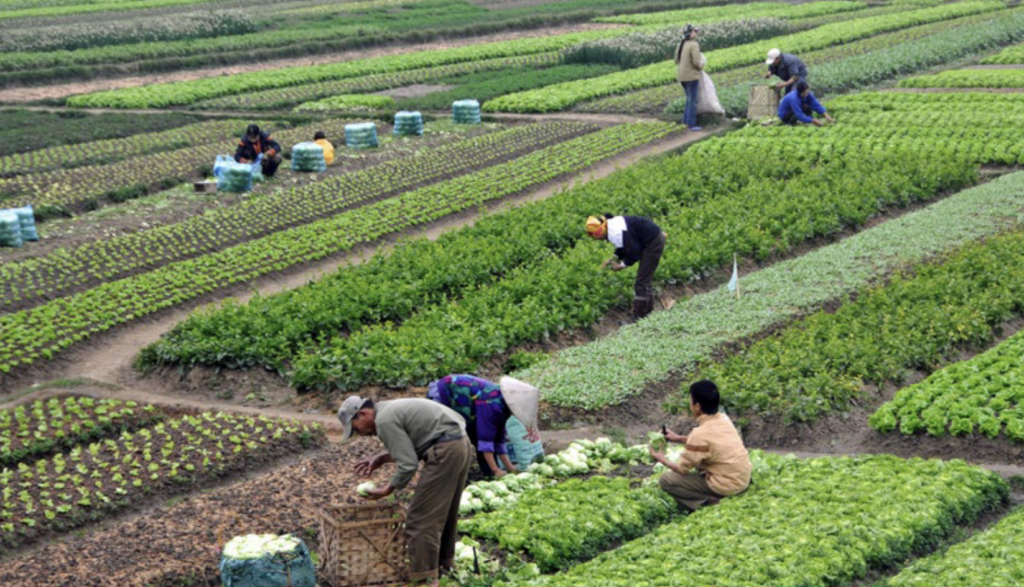

In other words, we can—and should— together imagine alternative, inclusive, sustainable and transformative futures, making them tangible. The time to do this, at scale, is now. The Foresight4Food Global Workshop, taking place in Jordan from 15-19 June, will include an exercise on ‘Radical Food System Futures’. This will harness the collective intelligence of the foresight and food systems community, and enhance focus on imagining very different food systems than we see around us today.
Preparations are well underway for the 5th Global Foresight4Food Workshop set to take place in Amman, Jordan, from 15 to 19 June 2025. This dynamic event will bring together foresight thought leaders, innovators, and changemakers from around the world. Designed to spark dialogue, ignite creativity, and drive tangible progress, the workshop offers a unique platform to advance the global foresight agenda for food systems.
In the lead-up to the event, Asem Nabulsi —Foresight4Food FoSTr Programme Deputy Facilitator in Jordan—shares his perspectives on the critical challenges and emerging opportunities shaping global food systems. In this blog, he offers valuable insights into the urgent need for systemic change and highlights the powerful role foresight can play in building a more equitable, nutritious, and sustainable future.
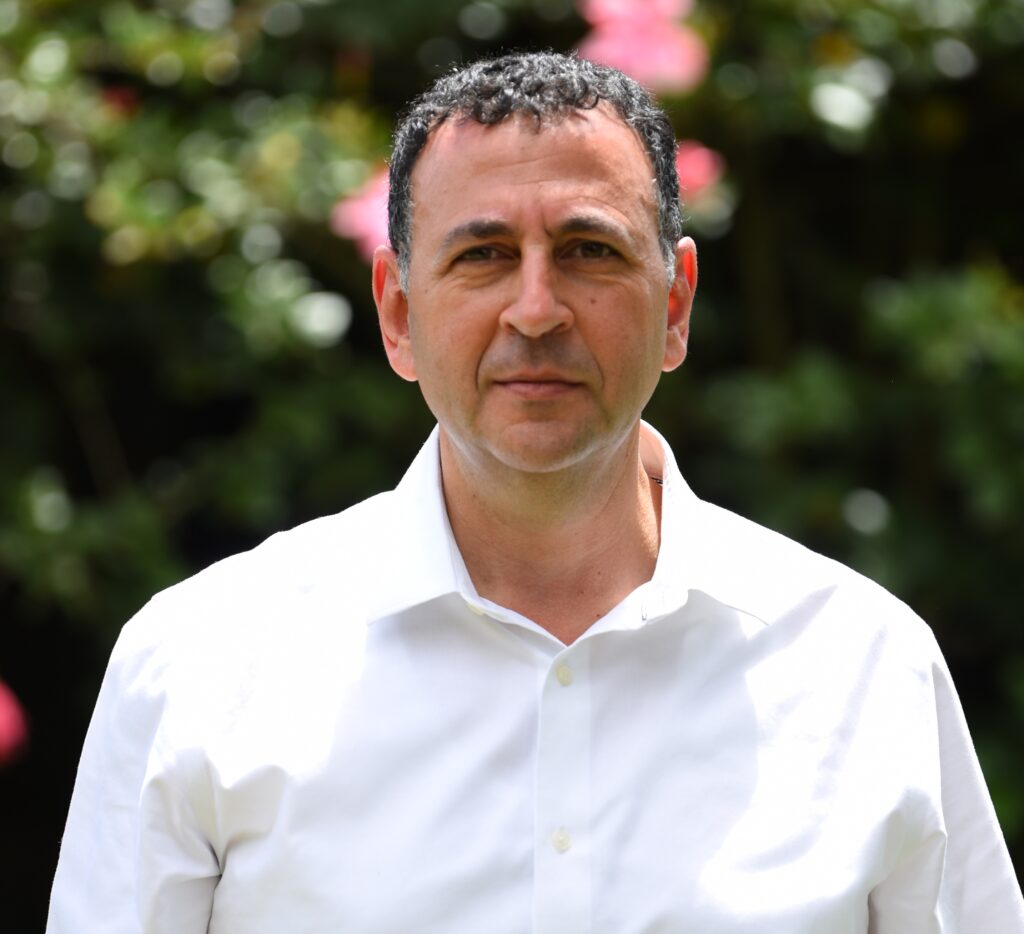
Beyond the Macro Lens: Reclaiming the Food System Narrative
A critical concern shared by many in the global food space is that the decisions influencing food systems are often made at the macro level, detached from the lived realities of communities and the interconnected outcomes they produce. The fragmented approach overlooks how policies and practices affect health, nutrition, livelihoods, and the environment. Foresight provides the structure to consider these dimensions together, helping stakeholders envision multiple futures and make informed, holistic decisions.
Sharing Real-world Experiences
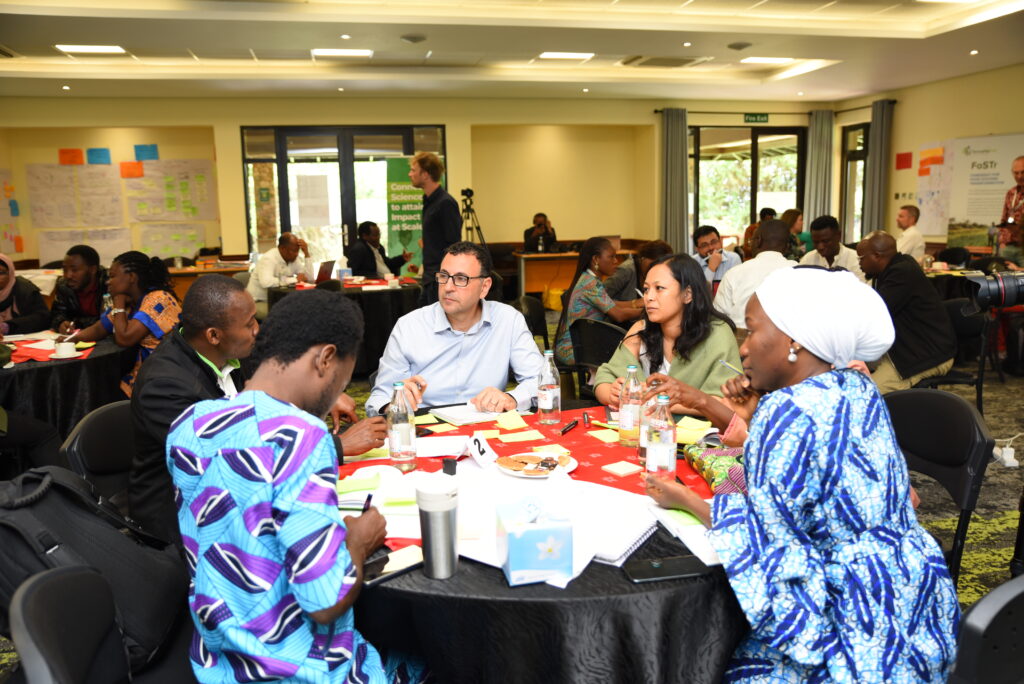
The success of the upcoming Foresight4Food Global Workshop hinges on more than dialogue—it depends on active participation, sharing real-world experiences, and co-creating concrete, implementable recommendations.
When foresight thought leaders, innovators, and food system stakeholders from around the world sit together, it should not just be about knowledge exchange; it should be about laying the groundwork for lasting change through mutual understanding and collective action.
From Dialogue to Action: Integrating Insights into Practice
I see this global workshop as a springboard to rethink professional strategies. One needs to fully understand the importance of multistakeholder perspectives and collaborative design of actions that consider the full spectrum of affected groups. This approach ensures that decisions are not only visionary but grounded in equity and practicality.
Regional Collaboration: The Untapped Potential
While food systems are often discussed within national borders, I would like to remind you that no country exists in a vacuum. Regional interdependence, from raw materials to trade and market access, necessitates greater collaboration. To build more resilient food systems, I suggest enhancing bilateral and multilateral trade, establishing regional food hubs, diversifying trade routes, and creating supportive regulatory frameworks. These steps could buffer regions against future disruptions and strengthen food sovereignty.
The Leadership Imperative
Leadership is essential for steering transformation. Setting a suitable regulatory environment, mapping the current food system and agreeing on the goals and best way forward to reach the desired goals, fostering a cooperative environment for change, uniting stakeholders understanding and action towards the desired goals, taking the decisions and actions that incentivise actions that enhance positive food system transformation at the different levels and for different stakeholders, raising awareness for all actors affecting and being affected by food systems, creating a national re-iterative process to regularly examine the efficacy of changes made and looking out for changing factors that might affect the food system, and starting the communication and actual practical steps for regional cooperation.
From Vision to Implementation: Making Collaboration Stick
A practical roadmap to ensure the workshop leads to a lasting impact is to focus on the importance of moving from vision to implementation. It means building a shared understanding, defining common goals, and designing actions that are informed by the perspectives of diverse stakeholders across multiple levels. Open discussions around potential trade-offs and strategies to mitigate negative impacts are also key. To translate dialogue into action, I would highlight the need for clear, well-defined plans with assigned responsibilities and timelines. I believe that this structured yet adaptable approach is crucial for fostering durable cross-sector collaboration and meaningful progress.
With these reflections in mind, I look forward to welcoming you in Jordan and seizing this unique opportunity to catalyse both regional and global efforts toward meaningful food system transformation.
By Bhawana Gupta and Monika Zurek
What if the future of our food system looks nothing like what we’ve imagined so far? Our recent report “Food systems of the future” examines how foresight studies are shaping our view of what’s to come. It reveals the urgent need for a new wave of forward-thinking work that dares to imagine fundamentally different food system configurations. Next-generation food system scenarios must embrace a new change paradigm, innovative methodologies, and a clear pathway to incentivise action through a deeper understanding of future drivers and enabling environments.
Why do we need another global-level scenario study?
We live in what many call the acceleration phase of the Anthropocene, an era defined by rapid and unpredictable change. For years, scholars and practitioners across disciplines worked to unravel the complexities of our global food system, using scenarios as vital tools to explore how different forces shape its future. But it’s crucial to remember that these scenarios are not only built on data; our assumptions, beliefs also shape them, and our constantly evolving grasp of the drivers of change[i].
The evolution of food system scenarios reflects this shift. Early models mostly focused on projecting food production and demand based on population growth. Over time, their scope broadened to encompass factors like resource availability, climate change, policy shifts, and socio-economic dynamics. Yet, the turbulent events of the past five years—think of the global pandemic, geopolitical tension, and unexpected supply chain disruption—have shown us that even the most sophisticated scenarios failed to capture certain uncertainties.
Grappling with the multifaceted complexities of the future is undoubtedly a wicked problem. But by continually refining our foresight techniques, we can better prepare for future shocks and proactively design alternative pathways. Let’s explore the critical building blocks for this next generation of global food system scenarios.
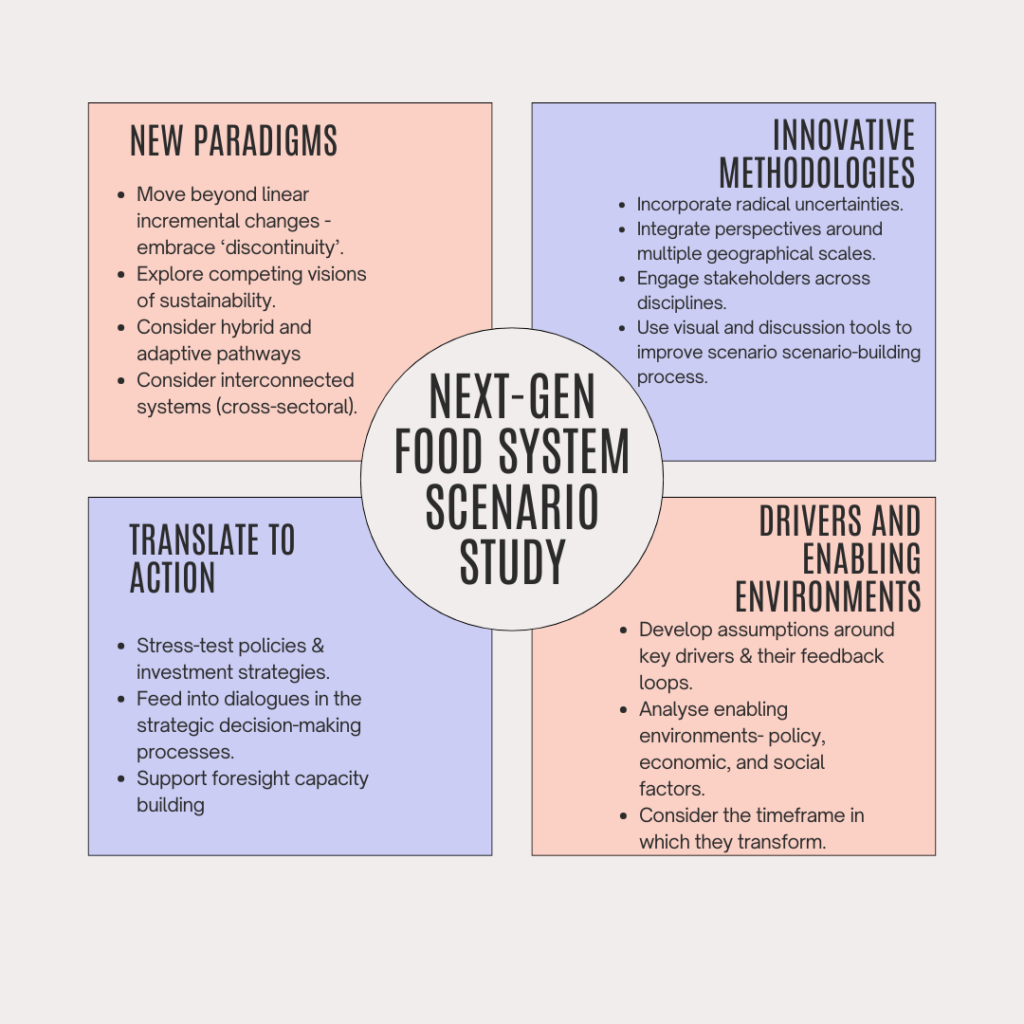
1. New paradigms
In Donella Meadows’ view, a paradigm is a shared set of beliefs, values, and assumptions that underlie a system. This core mindset dictates the system’s goals, structures, and operational rules. It follows that a paradigm shift is one of the most powerful drivers of lasting change within a system. For our discussion, there are three aspects that should be considered:
- Discontinuity: Past scenario studies often urged the inclusion of a surprise element or discontinuity[ii] (read box 1 for definition). However, these discontinuities were considered weak in almost all scenarios, especially quantified ones. Instead, scenario studies emphasised continuous incremental changes in the system. Going forward, our scenarios must move beyond a smooth and predictable evolution to explicitly explore non-linear changes, tipping points, and abrupt shifts.
BOX- 1
The term discontinuity is used variously in scenario literature, broadly signifying a sharp departure from past trends caused by high-impact developments, phenomena, and events. The significance of a discontinuity depends on its character, magnitude, speed, and ripple effects, and whether it has been anticipated and ameliorated. Here, a discontinuity refers to a significant shift of social-ecological structure and dynamics, rather than a transient perturbation after which the system reverts to its original trajectory. Related terms are surprises, bifurcation, critical transition, tipping points, tipping elements, wild cards, and black swan events. More recently, the phrase game changers has been introduced for shifts in how society is organized through understandings, values, institutions, and social relationships.
- Mental models: Since the IPCC’s ‘Shared Socio-economic Pathways’, most global scenario studies have relied on a mental model that assumes four broad pathways:
- A sustainable pathway characterised by progressive policy and technological adoption.
- A business-as-usual pathway, projecting a continuation of current trends.
- A collapse or environmental destruction pathway, depicting worst-case outcomes.
- A divided world pathway, where inequalities worsen and cause socioeconomic distress.
While seemingly intuitive the widespread use of this mental model is influenced by cultural biases, cognitive processes[iii], and the culture of scientific reticence[iv] (read box 2 for more). These factors can lead to the design of scenarios that are overly simple, feel intuitively right, and align with common ways of thinking about the future: an optimistic view, a middle ground, and a pessimistic view. We must challenge this reliance on simplistic archetypes and embrace more nuanced and multi-dimensional perspectives in our scenario development.
BOX- 2
Anchoring bias: We tend to rely too heavily on initial information, making it difficult to envision radically different futures.
Confirmation bias: We seek out information that confirms our existing beliefs, reinforcing the status quo.
Incrementalism: We assume change will be gradual and predictable, neglecting the potential for sudden, non-linear shifts.
Lack of interdisciplinary input: Many scenario studies are limited by the perspectives of a narrow range of experts, missing crucial insights from other fields like sociology, ecology, and complexity science.
- Cross-sectoral linkages: Too often, scenario studies operate in isolation, focussing on a single system like food. They fail to incorporate the strong interdependencies with other critical systems such as energy, water, or social systems. This approach can create a lack of understanding of the potential for cascading system failures, or conversely, unexpected positive feedback loops. Future scenarios must explicitly model these intricate interconnections, exploring how changes in one sector can trigger ripple effects across others.
2. Innovative methodologies
Advancing food system scenarios requires leveraging innovative methodologies, for example:
- Multi-scale analysis: Most past food system scenario studies focused on processes at specific geographic scales. Yet food systems operate across a spectrum, from individual households to global markets, with numerous complex inter-dependencies. These dynamics need to be captured in the future studies. The methodology for linking scenarios at different scales was explored by Zurek et al[v]. By integrating local, regional, and global food system dynamics, we gain a more holistic understanding of potential futures.
- Radical scenario development: The scenarios developed in the last decade have often underplayed outlying, surprise, or disaster events[vi]. Yet the inclusion of diverse and radical uncertainties can advance the quality and utility of scenarios[vii]. The development of radical scenarios combines established scenarios with group discussion techniques, as discussed in Talwar et al.[viii]. We need to better embrace wild cards and black swans as integral parts of scenario development, exploring how low-probability, high-impact events can reshape the future.
- Multi-disciplinary expert involvement: Food systems are inherently complex and interconnected, necessitating the involvement of actors across multiple sectors (e.g., agriculture, trade, health, and environment) and governance levels (from local to global). Innovative participatory methodologies such as Transdisciplinary Foresight Labs[ix] and Causal Layered Analysis (CLA)[x] can unpack issues on various levels and uncover underlying assumptions around litany, systemic causes, worldviews, and myths that shape expert opinions. Together, these methodologies support more holistic, inclusive, and imaginative scenario processes.
3. Drivers and enabling environments
Today’s scenarios commonly describe assumptions around the drivers of change (e.g. technological shifts, demand patterns, and trade dynamics). Next-generation studies must go further and reflect on the enabling environments that shape the dynamics of future food system drivers and the timeframe within which the change unfolds. This includes[xi]:
- Policy and governance: How do regulations, institutional capacity, and international agreements shape food system operations?
- Economic and financial structures: How do investment patterns, trade dynamics, and economic inequality influence food access and production?
- Social and cultural context: How do changing consumer preferences, social equity, and cultural norms drive food demand and system practices?
- Technological and infrastructural frameworks: How does digital connectivity, research and development (R&D), and infrastructure development enable or constrain food system innovation?
- Environmental governance: How do policies and practices regarding resource management and climate change impact food production sustainability?
4. Translate to action
Developing next-generation scenarios is not just an academic exercise. To be truly impactful, these studies must bridge the gap between foresight and implementation, ensuring that scenario narratives translate into policy and strategic actions. This involves:
- Using real-world stress tests: Running policies and investment strategies against multiple scenario conditions to assess their resilience.
- Embedding scenario thinking: Integrating foresight and scenario planning directly into decision-making processes at national and global levels. (Read about institutionalising foresight in decision-making in another blog).
- Engaging non-traditional stakeholders: Involving a broader range of voices, including grassroots organizations, indigenous groups, and regenerative farmers, to develop a shared language around food systems and future pathways.
Conclusion
Essentially, the prevailing paradigm in many current scenario studies inadvertently restricts our imagination and limits our collective ability to envision and prepare for truly transformative change. It creates an illusion of control in a world that is far more contingent and unpredictable. The necessary shift towards scenario studies that adequately reflect paradigm shifts is a complex but crucial endeavour, requiring a fundamental rethinking of how we construct and interpret future possibilities.
The food system of tomorrow will not be shaped by predictions, but by our collective capacity to anticipate, adapt, and transform. Advancing next-generation global food system scenarios requires bold thinking, cross-sector collaboration, and an openness to radical possibilities. The question remains: are we ready to embrace this challenge?
[i] Cork, S., Alexandra, C., Alvarez-Romero, J.G., Bennett, E.M., Berbés-Blázquez, M., Bohensky, E., Bok, B., Costanza, R., Hashimoto, S., Hill, R. and Inayatullah, S., 2023. Exploring alternative futures in the Anthropocene. Annual Review of Environment and Resources, 48(1), pp.25-54.
[ii] Rothman, D.S., Raskin, P., Kok, K., Robinson, J., Jäger, J., Hughes, B. and Sutton, P.C., 2023. Global Discontinuity: Time for a Paradigm Shift in Global Scenario Analysis. Sustainability, 15(17), p.12950.
[iii] Cork, S., Alexandra, C., Alvarez-Romero, J.G., Bennett, E.M., Berbés-Blázquez, M., Bohensky, E., Bok, B., Costanza, R., Hashimoto, S., Hill, R. and Inayatullah, S., 2023. Exploring alternative futures in the Anthropocene. Annual Review of Environment and Resources, 48(1), pp.25-54.
[iv] Rothman, D.S., Raskin, P., Kok, K., Robinson, J., Jäger, J., Hughes, B. and Sutton, P.C., 2023. Global Discontinuity: Time for a Paradigm Shift in Global Scenario Analysis. Sustainability, 15(17), p.12950.
[v] Zurek, M.B. and Henrichs, T., 2007. Linking scenarios across geographical scales in international environmental assessments. Technological forecasting and social change, 74(8), pp.1282-1295.
[vi] Gupta, B., Zurek, M.B., Woodhill, J. and Ingram, J. 2025 submitted for publication to Frontiers in Sustainable food systems
[vii] Gordon, D., 2021. Radical Uncertainty: Decision-Making Beyond the Numbers. Quarterly Journal of Austrian Economics, 24(1), pp.206-210.
[viii] https://jfsdigital.org/2019/06/15/the-future-of-energy-reinvented-case-study-of-the-radical-scenario-development-approach/
[ix] Pólvora, A. and Nascimento, S., 2021. Foresight and design fictions meet at a policy lab: An experimentation approach in public sector innovation. Futures, 128, p.102709.
[x] UNDP (2022). UNDP RBAP: Foresight Playbook. New York, New York.
[xi] Gupta, B., Zurek, M., Woodhill, J., Ingram, J. (January, 2025). Food Systems of the Future: A synthesis of food system drivers and recent scenario studies. Foresight4Food. Oxford, United Kingdom.
By Marcos Esau Dominguez Viera, Foresight Modeling Expert, FoSTr Jordan
In early April 2025, I had the opportunity to attend the 10th Global Workshop of the Agricultural Model Intercomparison and Improvement Project (AgMIP10) in Texcoco, Mexico. The event brought together a vibrant international community of researchers dedicated to advancing the intersection of agriculture, climate change, and food systems transformation.
Marking a decade of collective progress, the workshop underscored the growing importance of rigorous, data-driven insights to inform transformative decisions at both local and global levels. In this blog, I spotlight a regional experience presented at the workshop—our work in Jordan, where we integrated quantitative simulation modeling with stakeholder engagement. This approach enabled local actors to explore and envision the potential impacts of diverse future scenarios on their national food system.
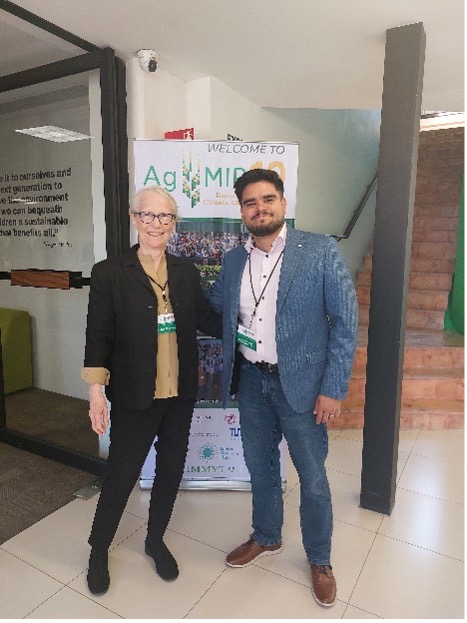
Participatory modelling approach for food system transformation in Jordan
Across the global econ modelling community, we are seeing growing interest in deep-dive studies at the country level. In this sense, I had the opportunity to speak at a session on regional integrated assessments of risk and adaptation options. I shared insights from our ongoing work under the FoSTr (Foresight for Food Systems Transformation) programme in Jordan. Over the past three years we’ve combined the power of MAGNET—a global general equilibrium model—with inclusive, participatory foresight approaches in the country. This iterative process brought together data and diverse perspectives to explore two very different scenarios for Jordan’s food system between 2025 and 2040.
I break down these scenarios in more detail below.
Two Futures: Business-As-Usual vs. Desired Transformation
Business-As-Usual (BAU)
- Jordan’s population hits 16 million by 2040
- GDP grows modestly at 2.6% annually
- Agricultural productivity is input-driven (mainly fertilizer use)
- Trade barriers and climate change threaten food security
- A continued shift toward Western diets
Desired Scenario
- Population growth slows (13 million by 2040)
- Regional conflicts do not affect trade
- Climate resilience increases
- Food loss and waste is cut by 50%
- Population shifts to Jordanian Mediterranean diet
What we’ve learned from the simulations
Our analysis shows that in a business-as-usual world, Jordan faces escalating challenges:
- Socially: Diets become less healthy
- Economically: The country grows more dependent on food imports
- Environmentally: Fertilizer use and greenhouse gas emissions intensify
In contrast, the desired future—though ambitious—offers promising synergies:
- A healthier population
- Stronger domestic production and potential export growth
- Reduced vulnerability to climate shock
But not all looks bright in the desired future. Some trade-offs remain, especially environmental ones. Increasing the production of healthy foods could still lead to a rise in chemical fertilizer use. A so-called “efficiency paradox” may occur, where a highly productive agricultural sector creates incentives to increase production for export markets, potentially intensifying emissions. That’s why we advocate for holistic policy bundles that tackle health, trade, and sustainability together.

Building Trust and Enhancing the Usefulness of Foresight Modeling
By actively involving local stakeholders—from government agencies to civil society—we were able to strengthen both trust in the modeling process and its perceived relevance. Partnering with the right in-country actors significantly increases the likelihood that simulation results will inform real-world decision-making.
Key partnerships played a critical role in this effort. In addition to the indispensable contribution of in-country facilitators, we collaborated closely with the Food Security Council, NAJMAH (National Alliance Against Hunger and Malnutrition), and the Embassy of the Netherlands in Jordan. This inclusive, participatory approach laid the foundation for developing context-specific solutions, such as strategies to reduce food loss and waste tailored to Jordan’s unique food system challenges.
What Sparked Participant Interest
Workshop participants were particularly engaged during the presentation, raising thoughtful questions about both the participatory process and the technical foundations of the work. Many wanted to understand the core components that defined our participatory approach and the key assumptions behind the contrasting scenarios—especially the policy mechanisms underlying the “desired future” pathway.
There was also strong interest in how the modeling results could be translated into action, particularly how they might shape or influence policy development. Some attendees were curious about the data sources used for the Mediterranean diet, while others focused on the composition of stakeholders and whether that mix evolved over the project’s three-year duration.
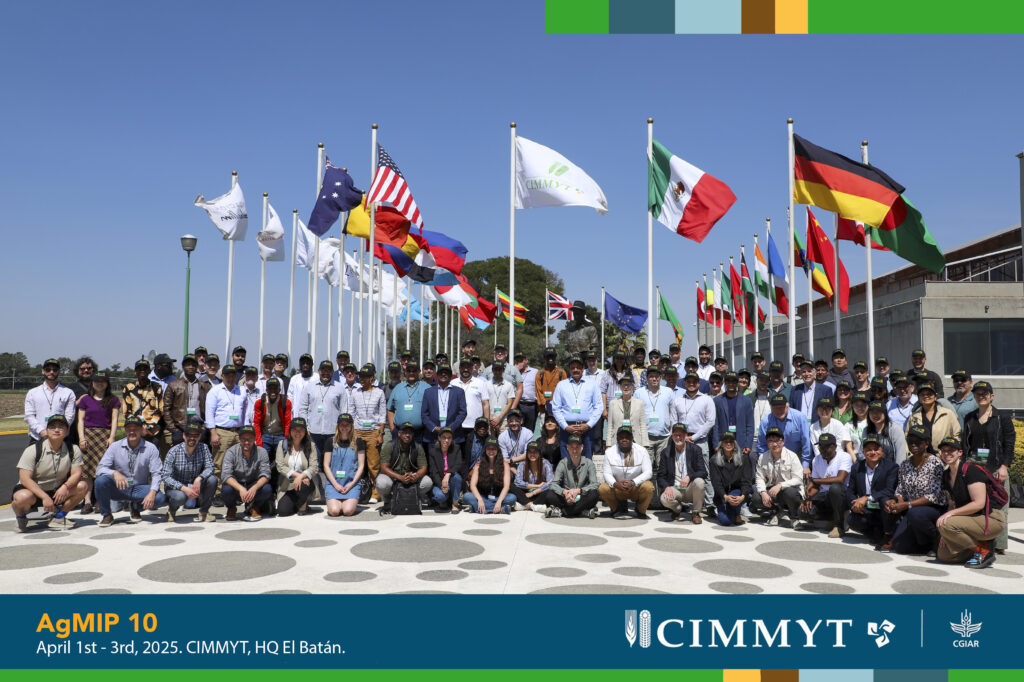
By Bart de Steenhuijsen Piters
Foresight4Food is organizing its 5th Global Workshop in June titled “Foresight for Transformative Action in Food System”. To raise the tip of the curtain on this exciting event, we have asked Bart de Steenhuijsen Piters, Senior Scientist Food System at the Wageningen University and Research and Foresight4Food FoSTr programme facilitator, to share some of his thoughts and expectations. Here is what he has to say:

The myth of the “Global” food system
As we approach the 5th Global Foresight4Food Workshop in Jordan, I find myself reflecting on what it truly means to transform our food systems—and what role foresight can play in helping us get there.
Let me begin with a provocation: I believe the idea of a global food system is, in many ways, an illusion.
When we speak about the global food system, we often forget that it’s simply the aggregation of countless national and subnational systems. No one actor is responsible or able to govern it. The UN may think so, but that is an illusion. Instead, we have trillions of individuals, institutions, and businesses shaping the system every day. This diffused responsibility makes governance incredibly complex and leads to a kind of mystification, where the real (geo)political and economic dynamics at lower levels are ignored or misunderstood. Yet, all these food systems are connected for sure. Just look at the effect of the Trump administration and its tariff policies on food markets worldwide.
This is precisely where foresight can help—not by giving us a top-down blueprint but by helping us navigate complexity, anticipate challenges, and co-create transformative pathways.
What success looks like for the 5th Global Foresight4Food Workshop
For me, success for the 5th Foresight4Food Workshop doesn’t lie in just producing new scenarios. It lies in helping us figure out how to act in those scenarios.
I want us to co-develop a joint narrative around food system transformation. I want us to compare how different countries are exploring their options. Most importantly, I want us to dive into the real-world, practical question: how do we move from insight to impact? How do we build pathways for change that involve multiple actors, each taking responsibility? And how do we lead, especially when the pathway forward is contested and uncertain?
These are the questions I hope we will tackle together in Jordan.
Regional collaboration is crucial
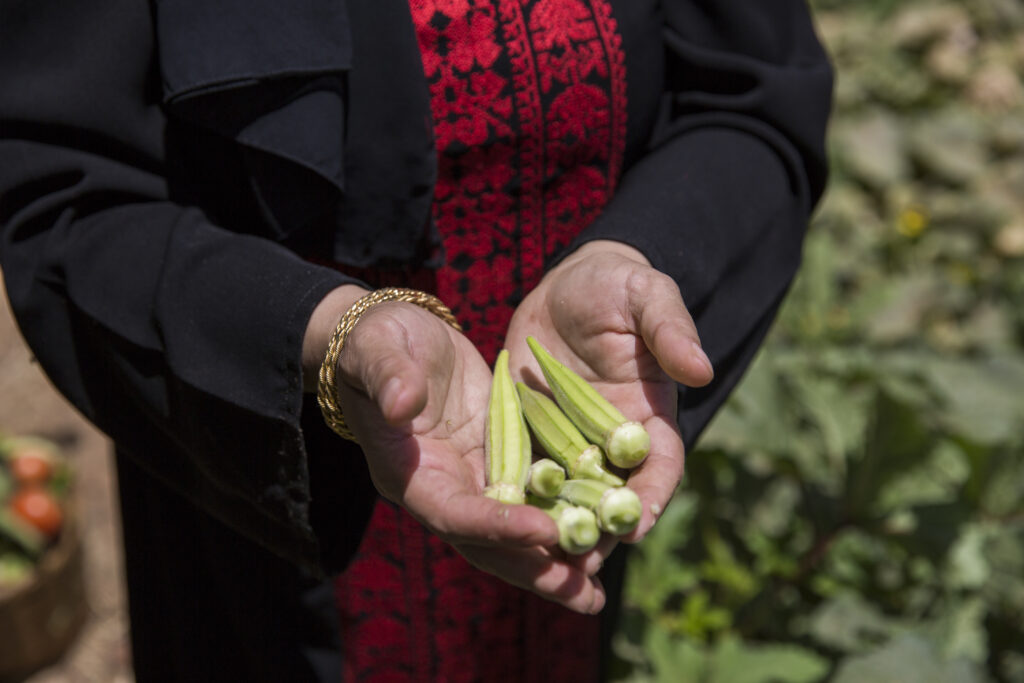
One of the most powerful levers for transformation is regional cooperation. Not only does it allow us to share experiences and foresight approaches among practitioners, but it also aligns with the need for more localized, resilient food systems. This is especially critical in times when global markets are being challenged, multinational food companies continue to concentrate their power and food is more and more used for geopolitical purposes.
We need shorter, regional supply chains and production systems that are better tailored to local contexts. Regional platforms are essential for this. They help us valorise knowledge and foster innovation where it matters most—on the ground.
The leadership we need
Food system transformation demands leadership on many fronts.
We need business leaders who are willing to shift course—who can rethink business models that currently drive unsustainable outcomes and align their strategies with public goals like healthy diets and environmental sustainability.
But we also need leadership that can manage conflict and mediate between diverse interests. Sometimes, this means making bold policy decisions, even when powerful actors resist change. That kind of leadership isn’t easy—but it’s necessary.
A call for courage and collaboration
My hope for this workshop is that it becomes a space of real collaboration. A space where participants listen to each other, share not only their successes but also their failures, and resist the urge to simply push their own agendas.
We need the courage to explore the unknown together. To ask hard questions. To face the uncomfortable truths. Because only then can we unlock the systemic changes our societies so urgently need—and that, too often, are still moving too slowly or stalling altogether.
I look forward to learning with and from all of you in Jordan.
By Mohammad Monirul Hasan, Foresight4Food FoSTr Bangladesh Facilitator
In December 2024, I had the privilege to participate in the Delivering for Nutrition (D4N) in South Asia: Connecting the Dots Across Systems conference, held in Colombo, Sri Lanka. This significant event, hosted by IFPRI in collaboration with CGIAR and regional partners, convened experts and stakeholders to tackle South Asia’s enduring nutrition challenges. Given the region’s double burden of malnutrition—persistent undernutrition alongside a surge in obesity and non-communicable diseases—the discussions underscored the urgent need for integrated, forward-thinking strategies to ensure sustainable nutrition security. Here are some of my insights from the conference.
Harnessing Foresight Research for Food Systems Transformation
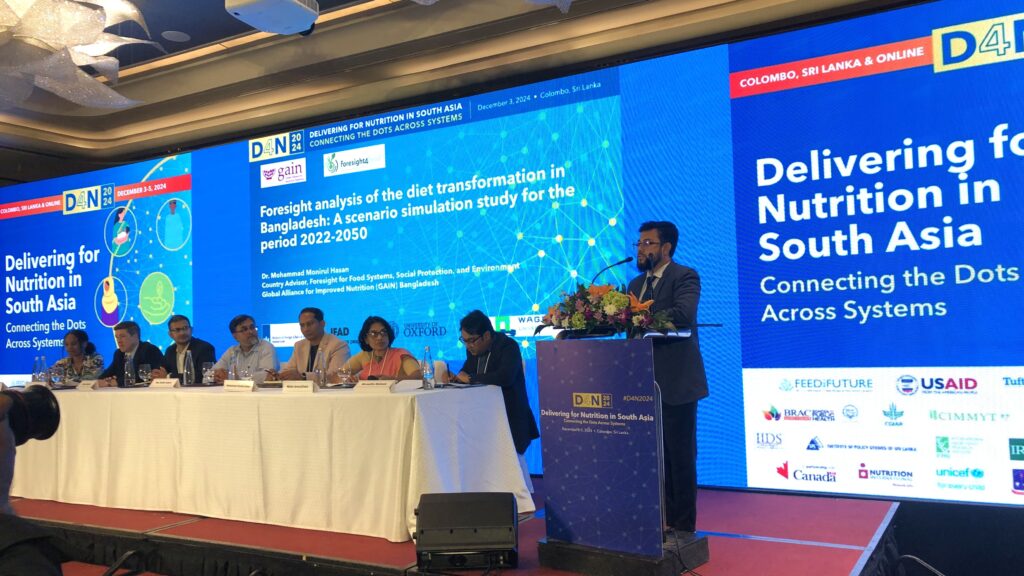
At the conference, I had the privilege of presenting our research on foresight-driven food systems transformation and the Diet Scenario 2050 for Bangladesh, a project supported by Oxford University, Wageningen University & Research, and GAIN. Our research employs foresight methodologies to anticipate future food system trajectories and design actionable pathways toward nutrition security. By leveraging scenario-building and participatory modeling, we explore how household decision-making, agricultural innovations, and policy interventions can collectively enhance food system resilience.
The Crucial Role of Foresight in Addressing Nutrition Challenges
The conference highlighted foresight methodologies as crucial tools for anticipating emerging trends and informing adaptive policy responses. In dialogues with IFPRI’s Foresight Team and CGIAR’s Food Systems Hub representatives, we explored critical gaps in food systems research and discussed collaborative approaches to align foresight insights with policy and investment strategies. Our discussions identified opportunities for:
- Evidence-Based Policymaking: Using foresight outputs to inform national and regional policy frameworks.
- Scenario Analysis: Modeling climate impacts, dietary shifts, and technological advancements to guide policy development.
- Cross-Sector Collaboration: Engaging agriculture, health, and education sectors to build integrated solutions.
Regional Collaboration and Investment for Food Systems Transformation
The conference provided a unique platform for fostering regional partnerships. Through interactions with policymakers, development agencies, and investors, we identified actionable steps to promote cross-border foresight initiatives that can enhance food systems resilience across South Asia. Key takeaways included:
- Shared Learning Platforms: Promoting knowledge exchange across countries to address common nutrition challenges.
- Regional Investment Frameworks: Encouraging collaborative investments in sustainable food systems and nutrition programs.
- Public-Private Partnerships: Mobilizing resources from diverse sectors to scale impactful innovations.

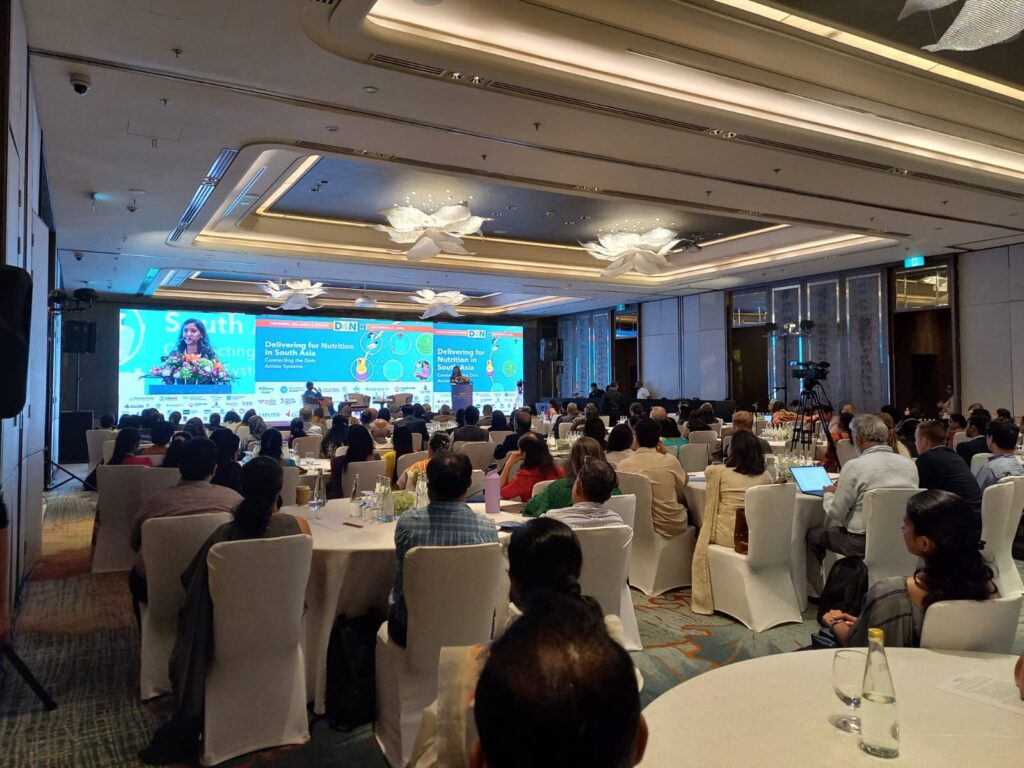
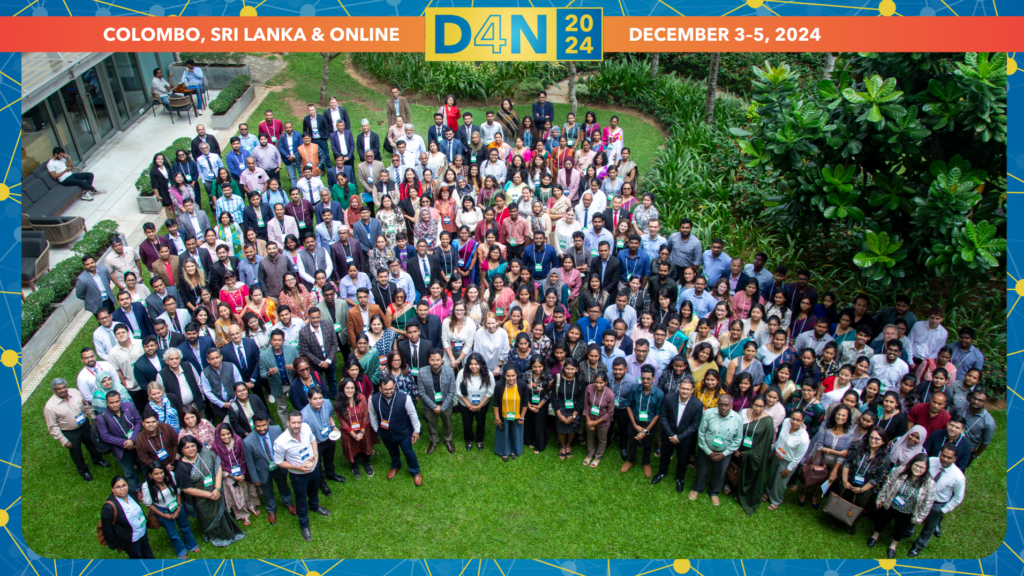
Insights for Policy and Practice: Moving Forward with Foresight
Key lessons from the conference emphasized the transformative power of foresight for achieving sustainable nutrition outcomes:
- Anticipatory Governance: Foresight can help policymakers proactively address emerging risks and opportunities.
- Systems Thinking: Integrating health, agriculture, and socio-economic perspectives is crucial for holistic solutions.
- Multi-Sectoral Collaboration: Effective partnerships between governments, academia, and the private sector are essential for impactful interventions.
- Investment Alignment: Foresight insights can guide investors to support high-impact initiatives that promote nutrition security.
Conclusion: Shaping the Future of Food Systems in South Asia
This conference reinforced the value of foresight methodologies in driving evidence-based decisions and fostering regional cooperation. It provided a platform to showcase Bangladesh’s commitment to forward-looking strategies and collaborative approaches that address the interlinked challenges of nutrition, climate resilience, and food security. Building on these insights, I look forward to advancing partnerships and implementing foresight-driven initiatives that contribute to sustainable food systems transformation across South Asia.
By Bram Peters
The future of food systems is uncertain, yet one thing is clear—transformative change is urgently needed. Climate change, inequality, and geopolitical instability are reshaping how food is produced, distributed, and consumed. How can we navigate these complexities and create a more sustainable, resilient food system?
At the Power of Foresight Workshop held on 30-31 January 2025 at the FAO headquarters in Rome, experts and practitioners gathered to discuss how foresight can drive food systems transformation. Their insights reveal a crucial truth: the process itself— working with complexity, embracing inclusivity, diverse perspectives, and collective intelligence—is central to making real progress.
Insights from the ‘Power of Foresight’ Workshop
- 17 different cases and the stories of 48 participants from 27 countries demonstrated that foresight approaches have much to offer to the process of food systems transformation
- Working with complex systems is what it’s about, and effective foresight practices for food systems change to embrace this
- Openness to new and inclusive perspectives should be central to all foresight for food systems transformation efforts
- The process brings the answer – and foresight can bring awareness of crucial process elements such as collective intelligence, agency, time and scale
- Embracing the ‘ifs’: how you do foresight, and what comes before and after, is just as important as the development of scenarios
- Foresight is not one approach or one methodology – there are a diversity of ways to go about it
- The national food systems pathways can benefit from foresight approaches
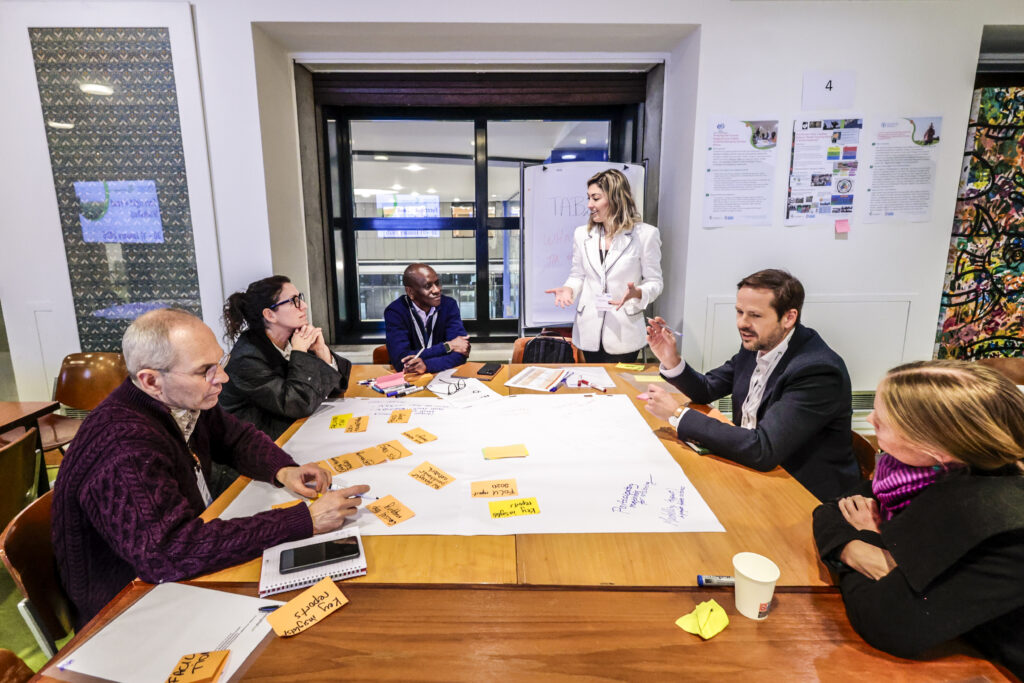
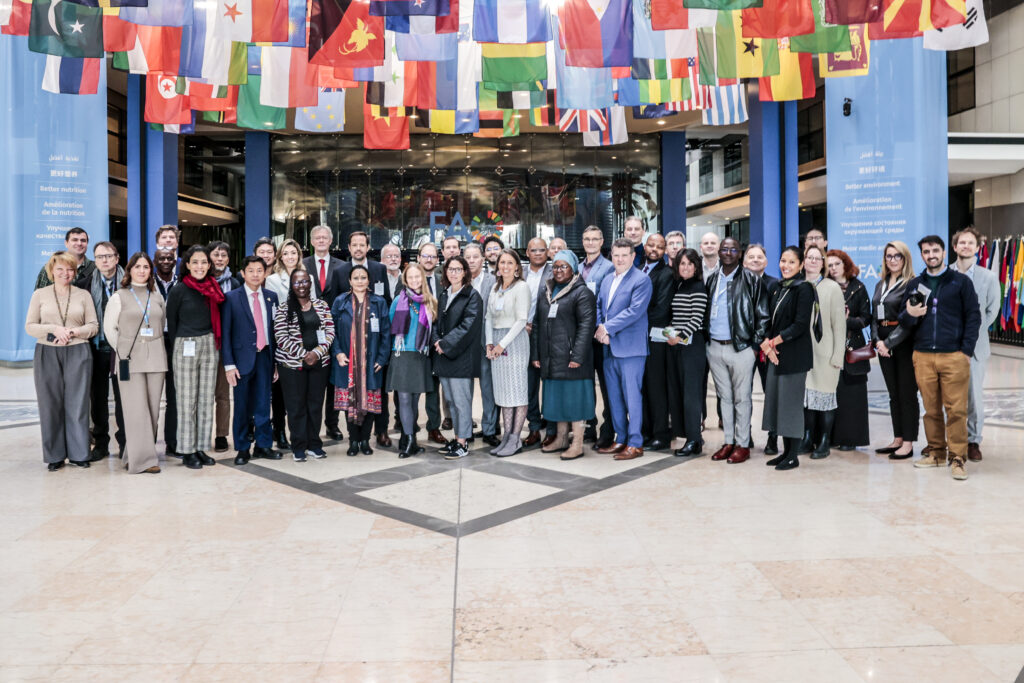
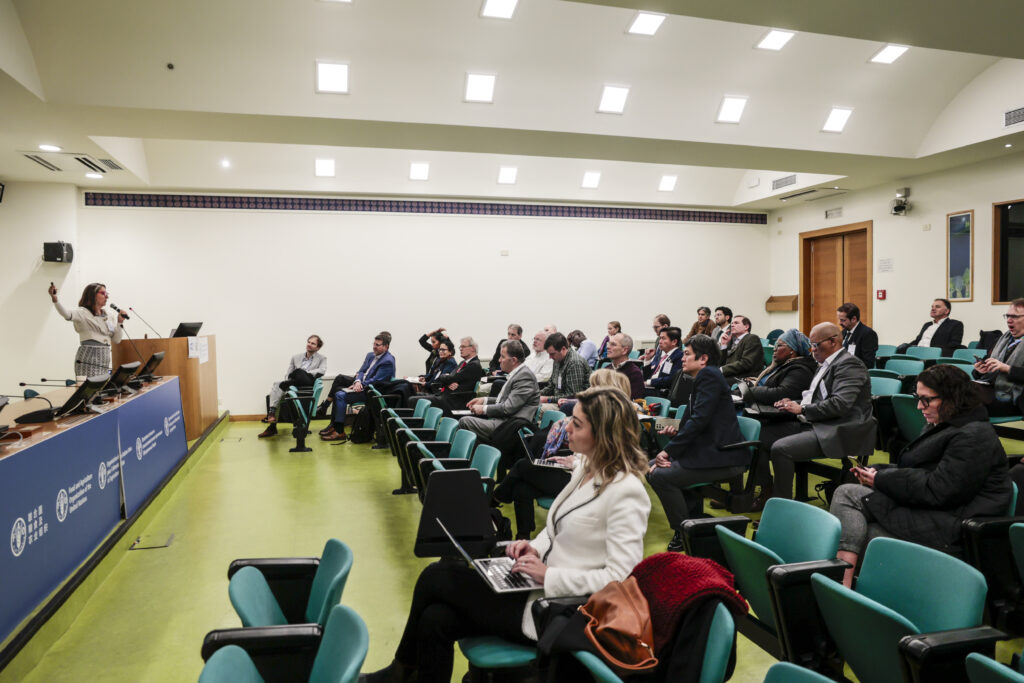
Photos: 30 January 2025, Foresight4Food workshop. FAO Headquarters, Rome. Photo credit: ©️FAO/Cristiano Minichiello
Working with complex systems: Let’s talk about the elephants in the room
When it comes to food systems transformation, there isn’t just one elephant in the room—there are many. These metaphorical elephants represent the complex, interconnected challenges we face, and ignoring them only hinders progress.
- First, as a whole range of interrelated challenges and assumptions we are not working on enough: whether that’s climate change, human rights, global geopolitical turbulence, growing inequality. All these challenges together form a context of global polycrisis.
- Second, we can see elephants in the room related to our apparent inability to take decisive transformative action in food systems: a lot of talk, limited action.
- Finally, we can see elephants as representing systems. An elephant can represent a dynamic, complex food system, of which we might only be able to see or understand the trunk, tusks, ears or tail.
Like the elephant and the blind men metaphor (see image to the right), food systems are deeply interconnected with global issues like climate change, inequality, and geopolitical instability. Tackling these requires a holistic approach, recognizing that transformation cannot happen in silos.
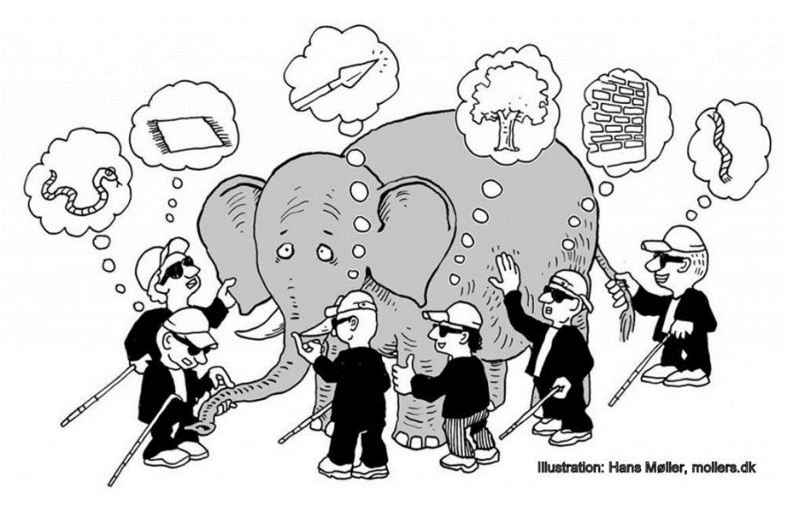
Gather new and inclusive perspectives – and change your own
What’s central to talking about complex food systems is perspective. We all have different mental images of food systems—whether local agriculture, marine ecosystems, or trade networks. Expanding our perspectives helps identify new entry points for addressing issues like malnutrition, poverty, and sustainability.

For some, like from the Pacific region, it’s about marine ecosystems in which food is central. Changing your perspective can be a helpful way of looking at a complex topic: such as to see the Pacific food system composed not of ‘small island states’ but rather ‘large ocean states’ connected with the global food system through trade, governance, and oceanic currents. Why is flipping your perspective so important? It helps to reframe entry points for discussion with other stakeholders and view the root causes of things like malnutrition, non-communicable diseases, poverty and human rights abuse in food systems differently.
If you are able to change your perspective, it helps to understand the viewpoints of those less heard. Having an inclusive process to gather different viewpoints is crucial to changing perspectives and behaviour, mobilising for collective action and creating shared visions of the future.
The process is the answer
Ever tried herding cats? Well, transforming food systems is about fostering C.A.T.S.—a process centred on:
- Collective intelligence – Multi-stakeholder collaboration and co-creation
- Agency – Empowering change through action
- Time – Bridging past, present, and future
- Scale – Recognizing interconnections between local and global systems
So, what does it mean to herd cats when talking about food systems? It means there are no magic bullets: the process is central to the outcome.
Effort on addressing the ‘ifs’
Foresight can be of great added value to support the food systems transformation process. Whether it is about co-creating alternative futures, conducting backcasting towards a more desirable scenario, highlighting the cost of delayed action, or informing anticipatory policy – foresight and scenario tools are a key toolbox in the hands of systems change champions.
In order for foresight to be effective, there are a number of conditional ‘ifs’ i.e., if foresight experts and facilitators:
- Are able to move beyond added value, tackling pre-conditions, obstacles, and constraints affecting how stakeholders prepare for the future.
- Not only preach to the converted – we need to involve stakeholders who think and act differently
- Are cognizant of power differences, lock-ins and political economy
- Build on other approaches that also provide value, such as design thinking, human-centred development and mission-oriented policy making.
- Pay attention to what comes before and after the development of scenarios
Scenarios only developed from the perspective of single organisations or without meaningful consultation and dialogue will not be effective.
Foresight approaches and national food systems pathways
There are a broad range of foresight approaches, some expert-driven or participatory, others quantitative, experiential, creative or analytical. Each has their value – but these needs come from a clear user need and scope within a food system. However, it is essential to keep in mind that foresight is a tool, not a panacea, and cannot address all questions.
With 156 national convenors driving progress through implementing 137 national food systems transformation pathways, the upcoming UNFSS+4 Stocktaking Moment (July, Addis Ababa) presents an opportunity to share lessons and strengthen impact. What we have seen the past two days in Rome, is the incredible richness and diversity of initiatives that use foresight to support the food systems transformation process.
Sharing the lessons from these initiatives, communicating the potential of foresight, and supporting the national convenors to further realise the impact on transforming food systems outcomes will be crucial in the run-up to the Stocktaking Moment.
By Herman Brouwer, WUR lead for FoSTr and Wangeci Gitata-Kiriga, FoSTr Country Facilitator Kenya
How can foresight transform the lives of pastoralists, fishers, and farmers in Marsabit County, Kenya? Marsabit County faces formidable challenges, with the escalating impacts of climate change threatening its food systems and livelihoods. Despite decades of significant support from development partners and government initiatives, the tangible results remain limited. This begs the critical question, inspired by David Peter Stroh: Why, despite our collective best efforts, have we struggled to foster lasting, positive change in Marsabit’s food systems?
Foresight could hold the key. By enabling stakeholders to anticipate future challenges, identify sustainable solutions, and adapt to evolving realities, foresight offers a transformative approach to addressing the county’s persistent issues. It’s time to rethink strategies and align efforts to create meaningful, long-term change for Marsabit’s pastoralists, fisherfolk, and farmers.
We brought stakeholders together in December 2024 to explore the above question, and to make a start to imagine different futures for the food system in Marsabit. Naturally, this involved a highly interactive discussion on the current food system and how we got to this situation – using a data walk with up-to-date data and analysis, as well as system maps. This provided the basis to jointly understand the dynamics of how food systems change (or resist change) and imagine how the food system could change even further in the next 10-15 years. The stories that participants came up with, based on their lived experiences in four distinct sub-counties of Marsabit, evolved into four scenarios. We used one of these scenarios (the ‘ideal one’ called Ajako, meaning ‘paradise’ in the Borana language) to create a vision for the future. We then identified the initial pathways and building blocks required to work towards this Ajako scenario.
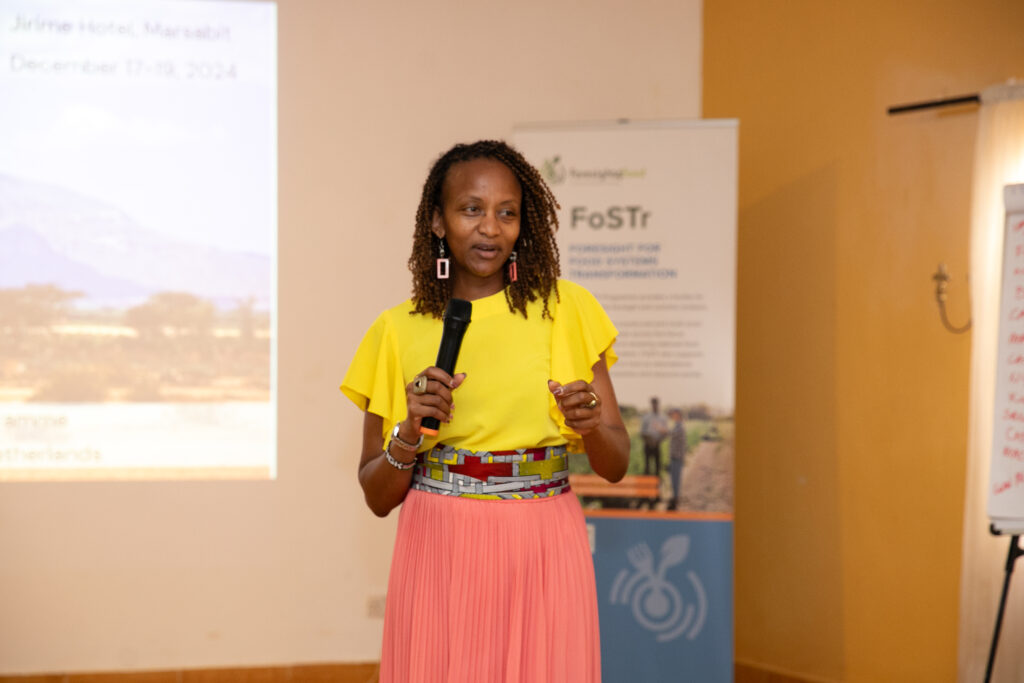
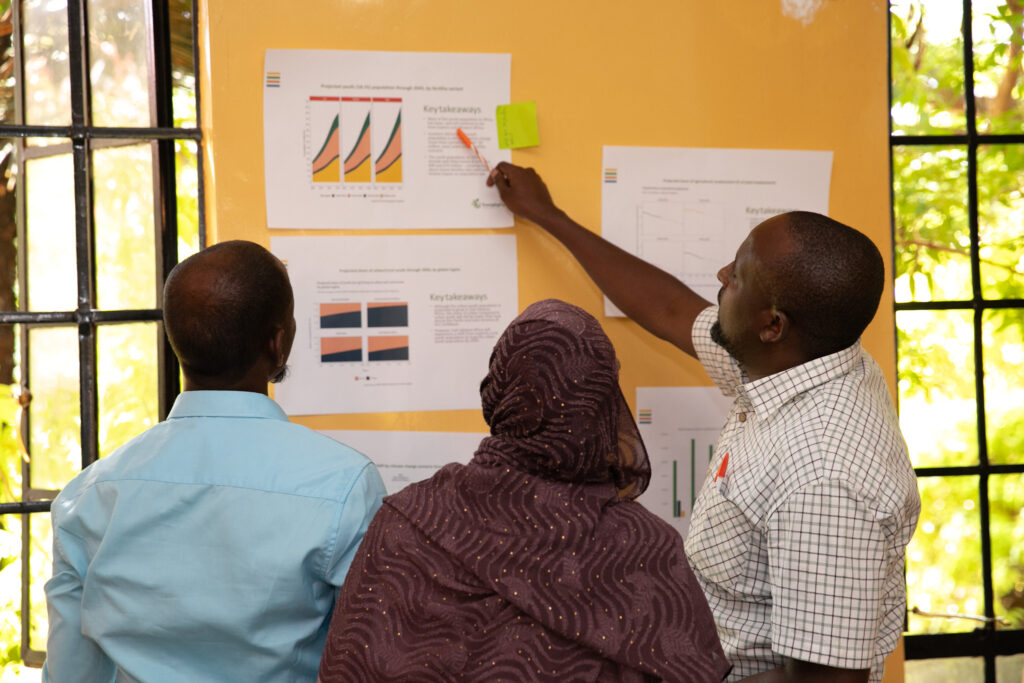
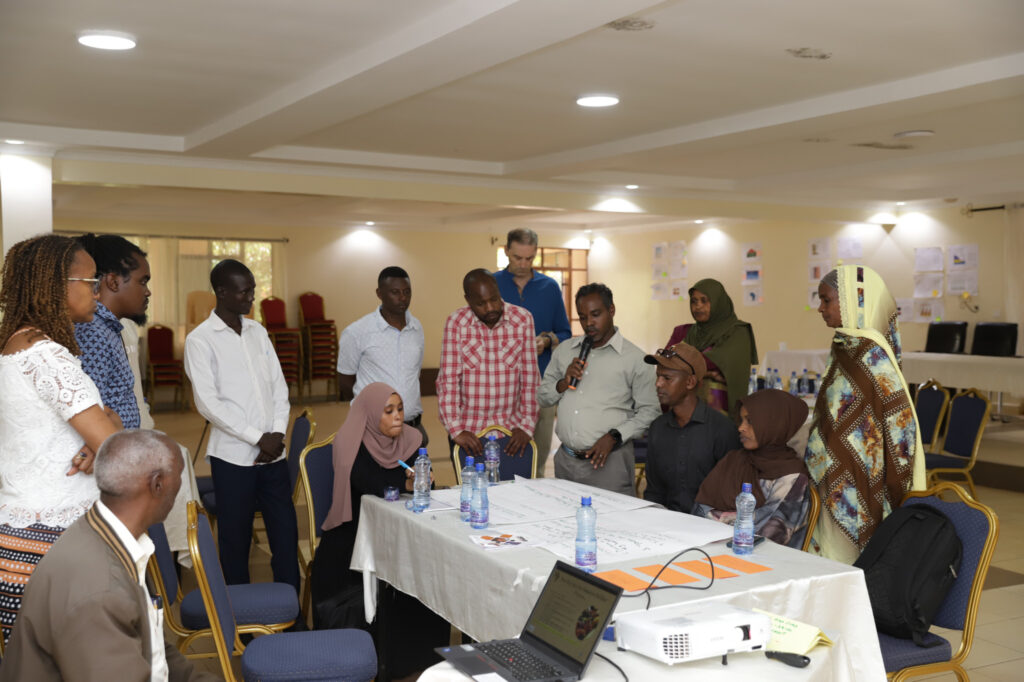
Photo credit: Crispaus Onkoba/SID, used with permission
That’s the summary of where we ended up. However, an essential detail was omitted earlier: How do you ensure the right individuals and institutions are in the room? Achieving this required a carefully planned stakeholder engagement process, which began several weeks before the workshop. The process involved numerous meetings with individual stakeholders across the county to understand who was doing what, who was most invested, what had been successful, and what hadn’t worked in the past. The ultimate goal was to mobilize the most relevant and diverse stakeholders for the 3-day workshop.
We started by engaging the county leadership, relevant government departments, and development partners. But stakeholder mobilization didn’t stop there. We actively sought out voices often overlooked in food systems discussions: faith-based organizations, community groups, and private sector representatives.
Following the workshop, we ensured the initial excitement and momentum were sustained by maintaining contact with key participants. This effort culminated in the formation of a County Development Group, coordinated by the county government. This group brings together all actors actively engaged in food security initiatives, creating a collaborative platform for sustained impact.
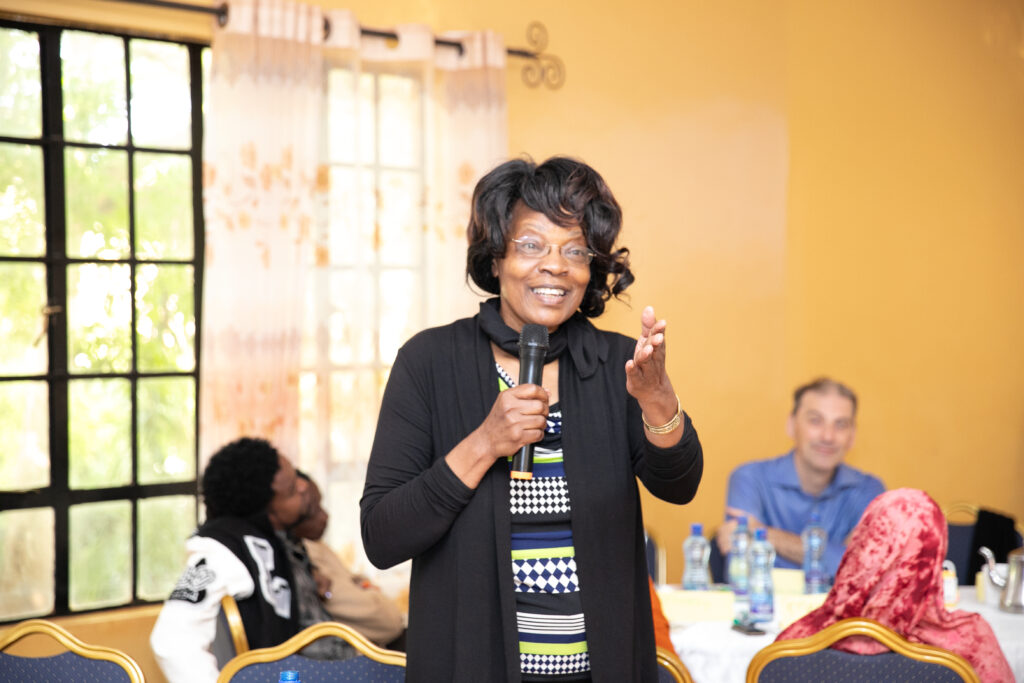
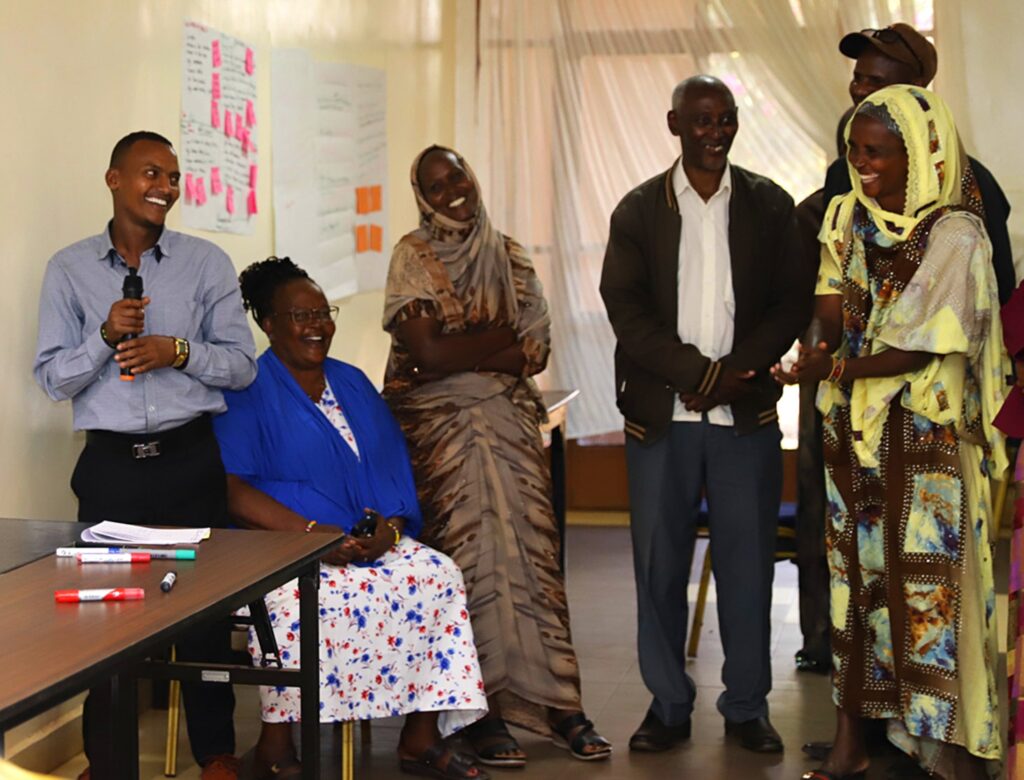
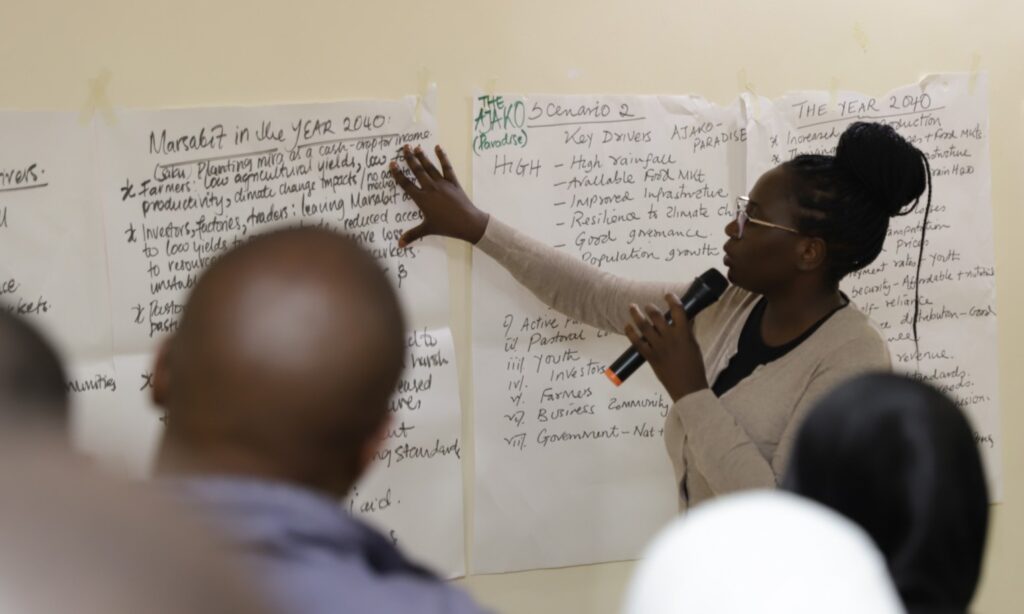
Photo credit: Crispaus Onkoba/SID, used with permission
We argue that the investment in stakeholder engagement has been the most valuable ingredient of the foresight process so far. It has allowed our Kenya foresight team to obtain the right endorsements and buy-in at the right levels. Without getting the engagement process right, all participatory foresight tools, and supportive analytics, are at risk of falling flat.
There is a case to be made to only report on foresight processes after they are concluded, rather than at the start. This blog is an exception, to make the point that how you start matters.
The FoSTr Kenya foresight team, consisting of Results for Africa Initiative (RAI); Society for International Development (SID); International Livestock Research Institute (ILRI); University of Nairobi; Food and Land Use Coalition (FOLU); Wageningen University & Research (WUR); and the University of Oxford, will continue to support the County Development Group in Marsabit to coordinate actions of state and non-state actors towards achieving Ajako by 2040. A similar process is taking place in Nakuru County. Both have active linkages to Kenya’s national food system science-policy interfaces.
By Jim Woodhill – Lead Foresight4Food Initiative
It was great to participate in the next phase of Jordan’s journey toward food systems transformation as part of the Foresight4Food Initiative. This significant step brought together around fifty key stakeholders on November 11 to discuss strategies for accelerating change.
The discussions built on earlier work from the Foresight4Food FoSTr Programme in Jordan, including scenario analyses developed during previous workshops, computer modelling results, and a series of policy briefs. These resources provided a foundation for the day’s explorations into actionable pathways for transforming Jordan’s food systems.
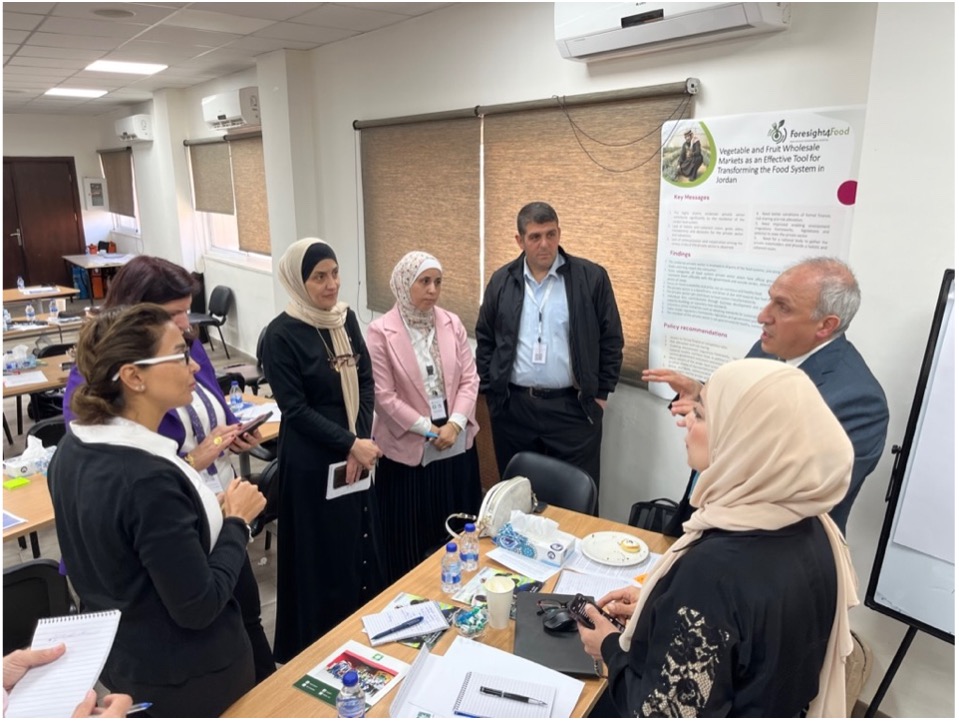
A key highlight of the workshop was the collaborative spirit among diverse stakeholders. This environment fostered consensus-building around critical challenges and opportunities. Participants examined deep-seated barriers to change, focusing on economic and social incentives, the power dynamics of various actors, and entrenched mindsets that hinder progress.
Drawing from detailed policy briefs on topics such as vegetable and fruit markets, food governance, the role of the private sector, and the contributions of civil society, the workshop delved into strategies for enabling meaningful change.
Informed by the policy papers on vegetable and fruit markets, food governance, the role of the private sector and the role of civil society, the workshop looked more deeply into how change can be brought about.
One particularly impactful aspect was the use of computer modelling, conducted with Wageningen University and Research’s MAGNET model. This analysis demonstrated the potential consequences of continuing current practices (“business-as-usual”) versus adopting healthier, more sustainable pathways. Such data-driven insights are instrumental for policymakers, equipping them with evidence to support investments and policy reforms.
Beyond the workshop, conversations with Jordanian universities explored integrating foresight and systems thinking into academic curricula. Additionally, a dedicated training session provided researchers and policymakers with hands-on experience using the MAGNET model to analyze food system changes.
The workshops were made possible with support from the Jordanian Hashemite Fund for Human Development (JOHUD) and the National Alliance Against Hunger and Malnutrition (NAJMAH), underscoring the importance of partnerships in driving food systems transformation.
By Zoe Barois
Like many other countries, Bangladesh is working to develop it’s Food Systems Transformation Action Plan. This will be presented during the United Nations Food Systems Summit Plus 4 Stocktaking event. On November 6 and 7, Foresight4Food collaborated with GAIN Bangladesh to host a workshop on how foresight could contribute to the development of the Action Plan.
If transforming food systems were easy, it would have been done! But it’s not. Discussions dug into deeper questions about HOW change can be brought about and the implications of this for action in Bangladesh.
The participatory and dynamic workshop brought together policymakers, researchers, youth leaders, key UN organisations and members of the private sector. The workshop served two purposes, first to help clarify directions for the Action Plan, and secondly, to take forward the work on using foresight to help drive food systems change.
Discussion during the workshop focused on the five commitment pathways:
- Nourish all people
- Boost Nature-based Solutions
- Advance Equitable Livelihoods, Decent Work & Empowered Communities
- Build Resilience to Vulnerabilities, Shocks and Stresses and
- Accelerating the Means of Implementation
Validating scenarios for the future of food systems in Bangladesh
It was great to engage in discussions around four visual future scenarios. These were developed using rich pictures during a lively multistakeholder event in June earlier this year. Future scenarios are an excellent way to open discussions around what different stakeholders see as a desirable future. Interestingly, these do not always align as the implications would vary depending on what outcomes you’re seeking. At the end of the day, a poor farmer will desire different things when compared to a corrupt businessman!
The scenarios displayed different outcomes based on these uncertainties:

Equity – Would there be high or low levels of equity?
Climate resilience – we all know that climate change is happening, but whether Bangladesh will have high or low climate resilience is definitely in question
Healthy food consumption – Would people in Bangladesh be eating traditional diets or would they follow a diet that resembles something like a North American diet, something seen in many parts of the world.
Business structure – would Bangladesh have a diversified or consolidated business structure, dominated by a few large conglomerates
Creatively naming these scenarios helps convey the messages. So we had a fun exchange where groups came up with poetic Bangladeshi names to better describe the scenarios. Part of the validation will be to update these, helping spur action towards the most desired and away from the least desired future.
Unpacking five critical issues
Key issues blocking progress towards food systems change in Bangladesh relate to:
- The cost of a healthy diet in addressing malnutrition
- Climate resilience
- The role of social protection programmes in shaping food systems change
- Fruit and vegetable production
- Land use change and dietary patterns
These key themes were the result of a longer participatory process that emerged from the food systems map of Bangladesh. Diving into these topics, FoSTr’s five research partners shared their work on the key trends, challenges, and opportunities within each theme. Exploring these themes using a future lens can help clarify desired directions of change.
The power of causal loop mapping
How often do you get policymakers, youth and researchers around one table, heavily immersed in discussion using sticky notes and flip charts? My response: not often enough! This combination of actors is rarely seen but proves oh so valuable in uncovering insights previously hidden from each sector. The tool casual loop mapping, may be familiar to some. It’s a systems thinking tool where the interconnections between elements are mapped and the direction of causality identified. It’s a great way to map out the elements within a system and identify levers of change – small actions that lead to a large impact. For each of the commitment pathways, this casual loop mapping was performed. Insights like forming alliances between farmers and entrepreneurs to boost sustainable farming practices, or using the power of advertising to improve healthy food consumption and inspire healthy lifestyles were uncovered.
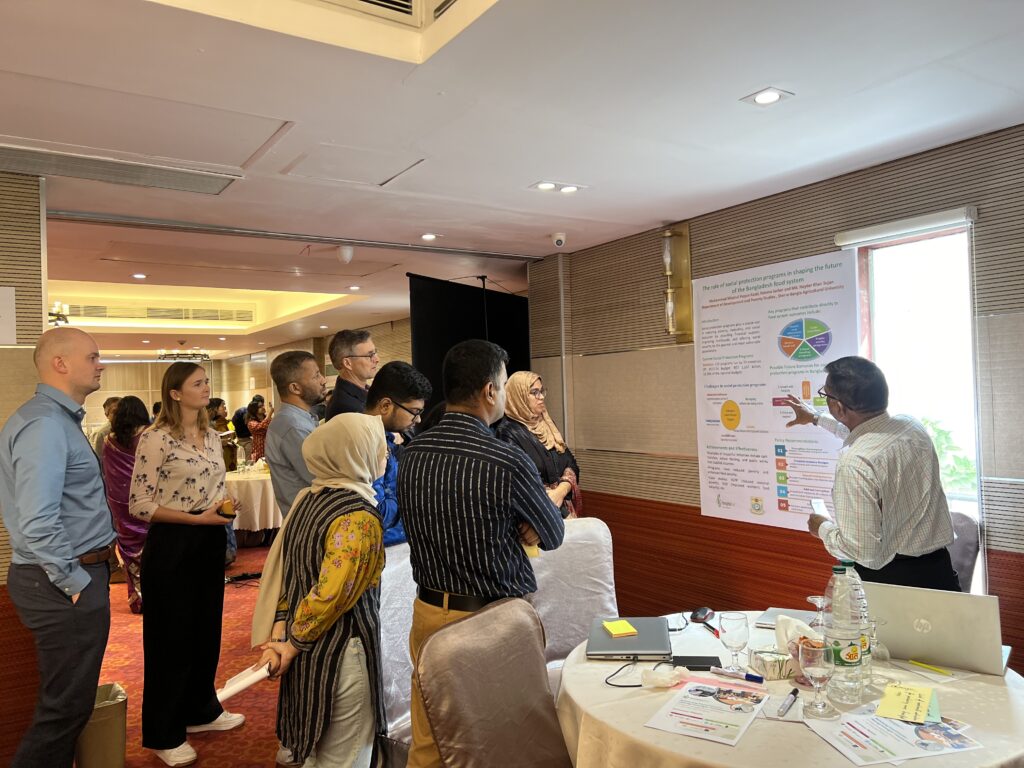
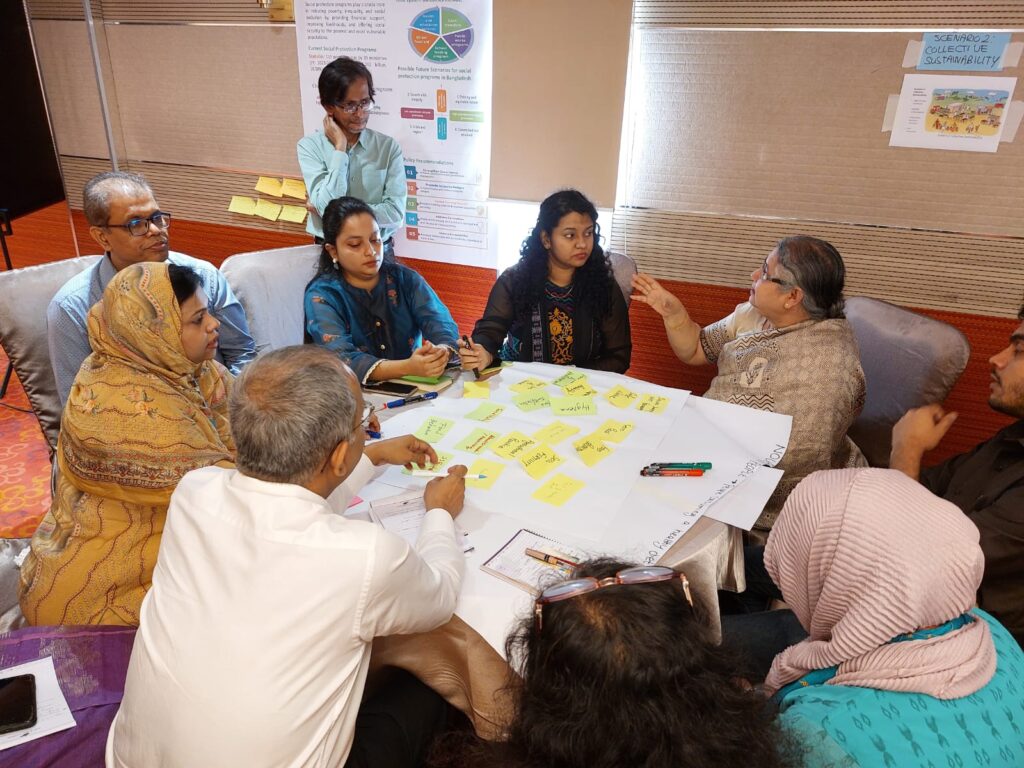
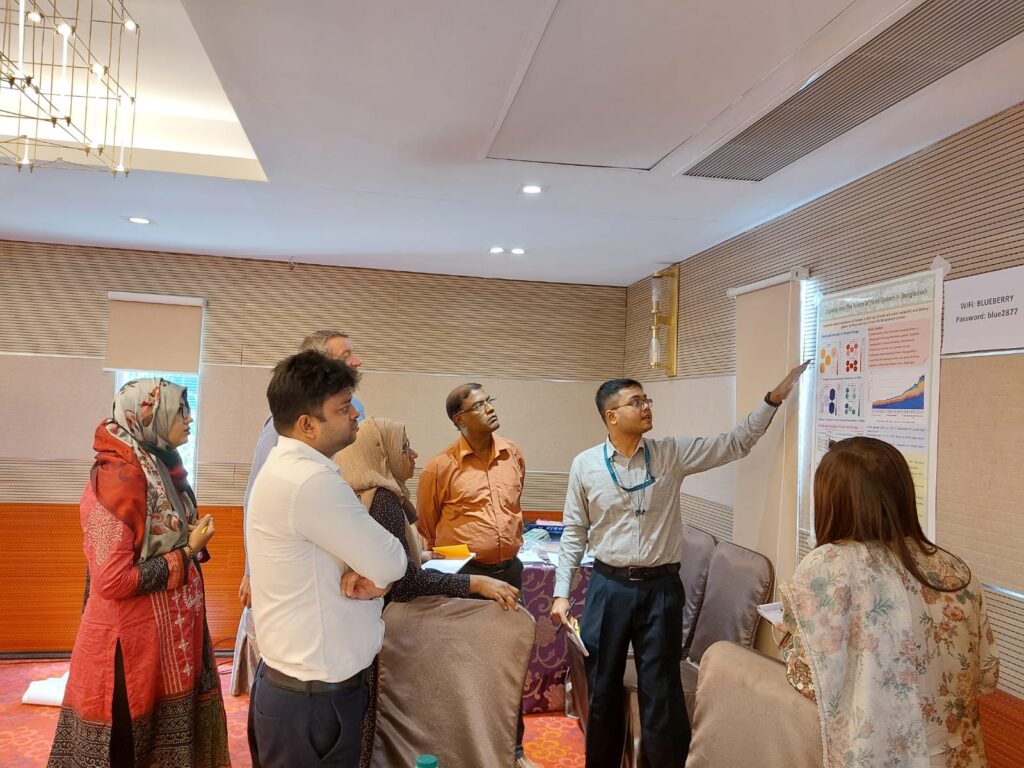
Reflections
Whilst having many people come together who don’t usually converse – the so-called ‘breaking the siloes’ is a huge achievement in itself, the task of writing yet another policy document looms above our heads. Everyone in the room has appeared here for a reason – which I hope is to create the change we need, a future that we all desire. After such positive discussions and recognition that we need to act – and act now, the fear I have is we will all fall into the same trap. The trap of being consumed by our busy agendas and becoming frustrated that yet another policy document has to be produced. Leading to un-actionable and hugely categorised actions. We don’t want this Plan of Action to become another document that has great suggestions but continues to lack the HOW. Let us think about how will these actions be implemented.
Foresight helps us to keep the bigger picture in mind, where do we want to go and where do we want to be in the future? Let’s use this thinking to help us prioritise and select key activities to implement. Working together to do so.
By Patrick Caron – President of Agropolis International, Montpellier, France
and Co-Chair Foresight4Food Initiative
In today’s rapidly changing world, it’s vital to reassess our approach to foresight if we aim to make meaningful transitions toward a better future. But first, I want to reverse the perspective. Why should we engage with foresight in the first place? Why should foresight be central to our strategy for navigating today’s uncertainties and transitioning toward a more sustainable world? This will enable us to see the value of foresight, while also urging us to explore new transitions in foresight practice itself.
Upcoming event
Join us for an insightful session on “Foresight Navigating Polycrises”, where we’ll explore how foresight approaches can evolve to help us navigate the complexities of today’s global polycrises.
The Polycrisis We Face
We are all aware that the world today is facing multiple, interconnected crises—what is increasingly referred to as a “polycrisis”. From climate change and environmental degradation to food insecurity, conflict, and mass migration, global interconnected crises are compounding in ways that make solutions more elusive. We see extreme weather events, challenges in livelihoods, and even migration crises, all feeding into one another. The agricultural and food sector provides a telling example of how this complexity plays out. In the 20th century, food security was often synonymous with simply increasing agricultural output to meet the needs of a growing population. But this approach no longer holds in the 21st century, where food systems must integrate issues like ecosystem health, social justice, and human well-being.
Beyond Agriculture: Foresight, Food Systems, and Global Goals
Foresight is essential for transforming food systems as it enables a long-term, integrated view of how food, health, climate, and equity intersect. As food systems now play a critical role in achieving multiple Sustainable Development Goals (SDGs), foresight helps policymakers, researchers, and stakeholders anticipate future challenges like climate change, resource scarcity, and population growth. This forward-looking approach is key to navigating complex global challenges and achieving the holistic transformation called for by initiatives like the UN Food Systems Summit.
At the same time, the polycrisis demands a systems-level approach. The transformation of food systems is no longer about just ending hunger (SDG2), but about achieving multiple Sustainable Development Goals (SDGs). Food systems now lie at the intersection of climate action, health, equity, and sustainability. This complexity was highlighted at the UN Food Systems Summit in 2021, where the call for a holistic transformation of food systems became clear.



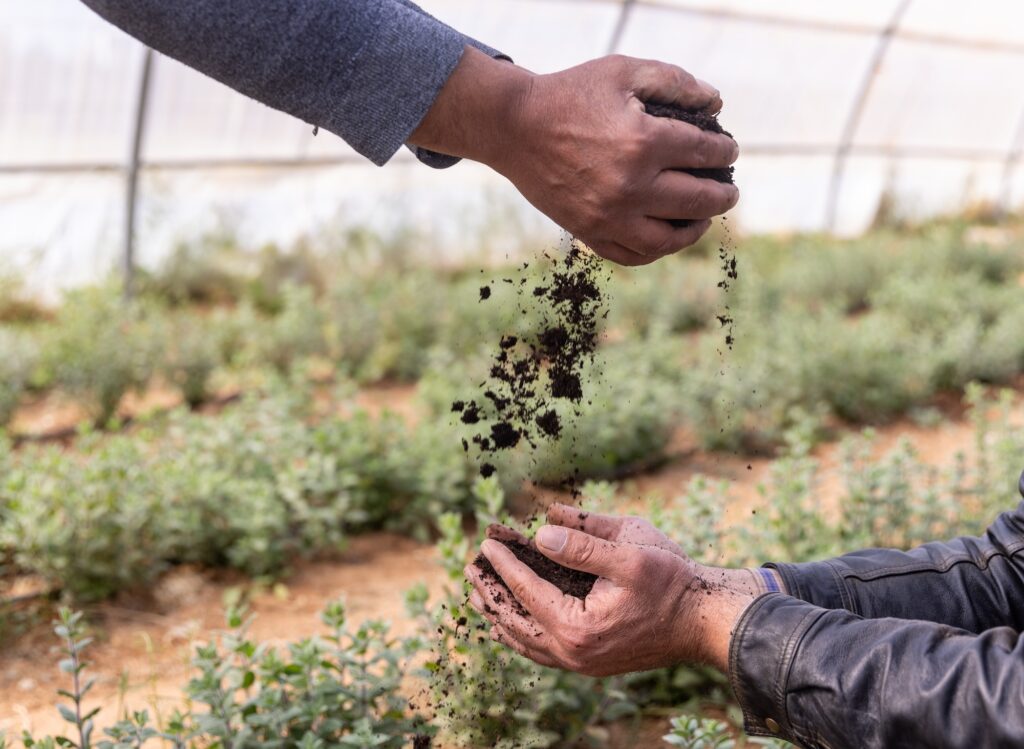
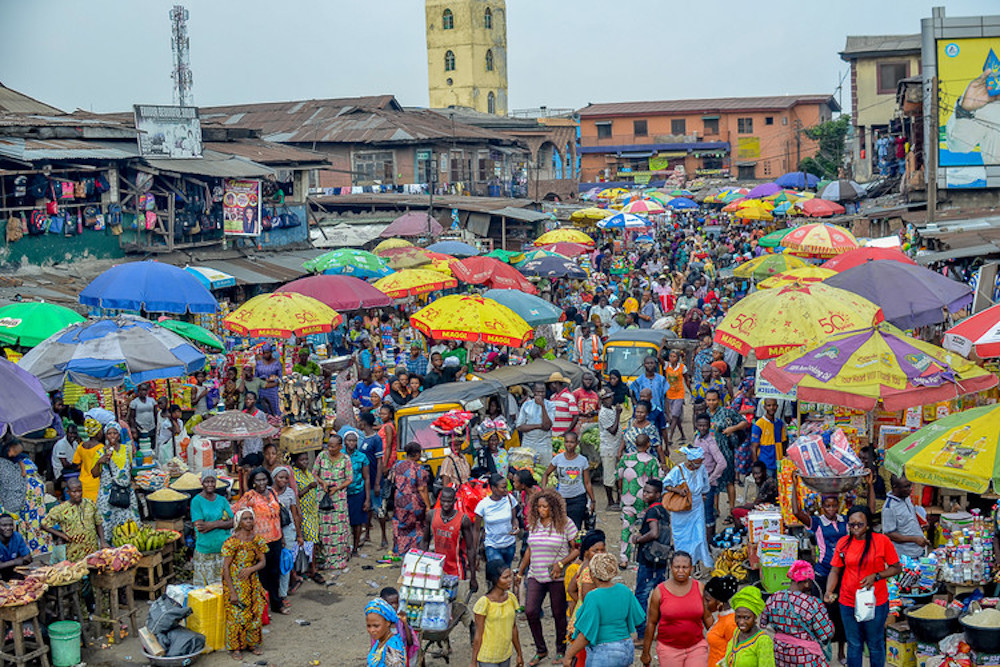

The Changing Role of Science
Science, too, is evolving. For much of the 20th century, there was a more linear view of science’s role: knowledge was generated, applied through technology, and action followed. Today, this model no longer applies. The polycrisis is too complex for linear solutions. We must embrace uncertainty, acknowledging that even science has limits and that collaboration across disciplines and sectors is essential.
Four Key Shifts for Foresight and Science
If we want to move forward, we need to embrace four critical shifts in how we think and act.
- From Forecast to Foresight
Forecasting has long been about identifying trends, but the future rarely follows a predictable path. We need to move beyond forecasts and embrace foresight. This means exploring multiple scenarios, understanding possible and plausible futures, and making decisions today that can shape those futures. Foresight, unlike forecasting, accepts uncertainty and the need for flexibility in planning.
- From Sectoral to Trans-Sectoral Action
Another key shift involves moving from siloed thinking to a trans-sectoral approach. Cities, nations, and scientific disciplines often focus on their own isolated priorities, which makes it difficult to address the interconnected nature of modern crises. For example, city officials may focus on water, transportation, or sanitation, while a Ministry of Agriculture focuses on food production, and scientists work within their own disciplinary boundaries. To address food security and other pressing global issues, we need to bring together health, agriculture, environment, and more into integrated solutions.
- From Certainty to Controversy
We also need to shift from seeking certainties to embracing and addressing controversies. Science has traditionally been about providing concrete answers, but in today’s world, differing perspectives and debates are inevitable. These debates are not just a sign of conflict; they are an opportunity to bring diverse views together to design better solutions. Rather than avoiding controversy, we need to engage in dialogue and even mediation, respect differing opinions, and work toward a shared understanding of why disagreements exist.
- Building Capacities for Collective Action
Finally, we must invest in developing capacities for collective action and innovation. It’s essential to create structures that allow diverse voices to be heard, including those who are often marginalized. We need to foster environments where science and policy can interact in meaningful ways, not through a simple transfer of knowledge, but through the co-creation of actionable solutions. This requires building institutional frameworks that support ongoing dialogue between policymakers, scientists, and communities.
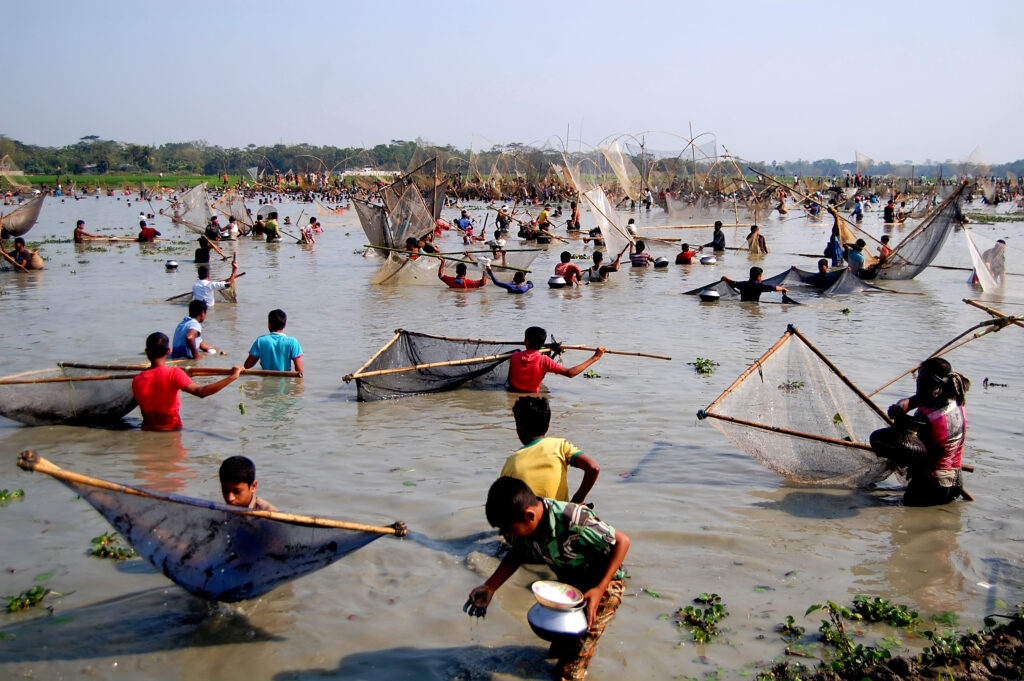
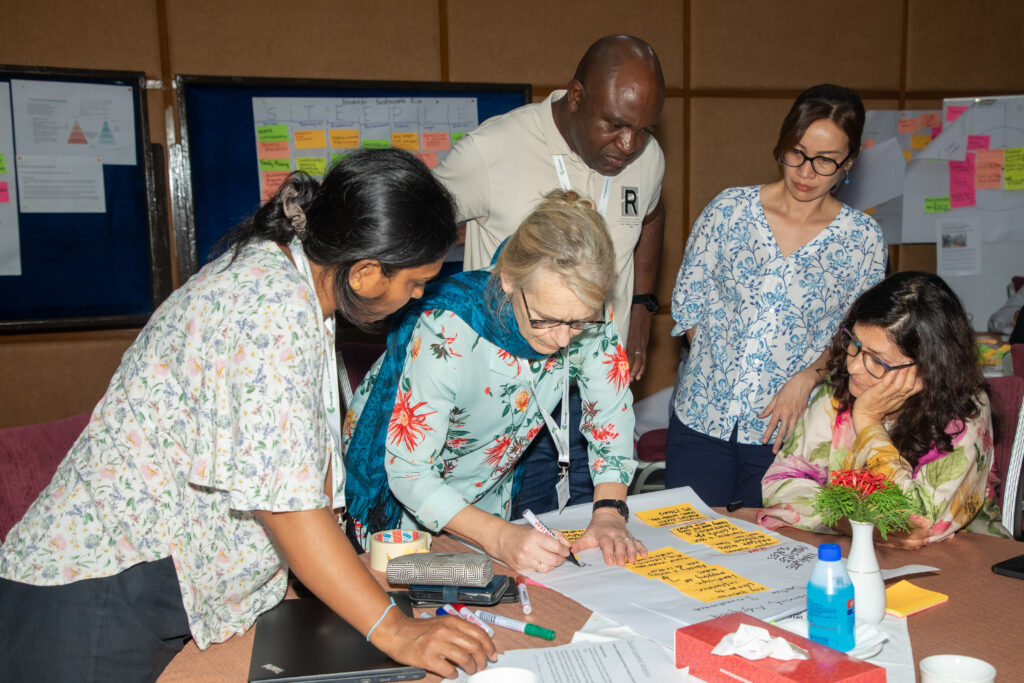
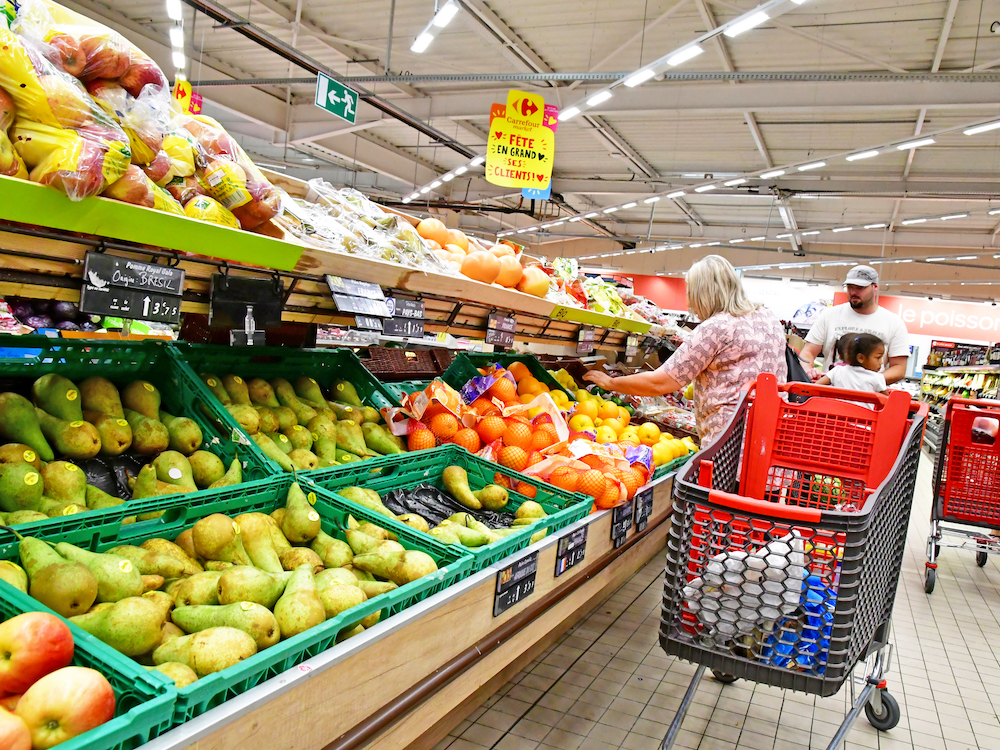
The Road Ahead – Foresight4Food and Global Change
Foresight4Food offers a way forward by pooling collective intelligence across agriculture, food, environment, and health. The path to a sustainable future lies in collaboration—across sectors, disciplines, and scales. From local to global, the interconnected nature of today’s challenges demands that we look beyond traditional boundaries. We must explore possible futures, engage with uncertainty, and develop innovative solutions that can help us move toward a more just and sustainable world.
The 2021 UN Food Systems Summit and other international initiatives, such as the Montpellier Process, show that while we are facing unprecedented challenges, we are also making strides in understanding how to address them. Foresight can help us navigate these complex dynamics, allowing us to envision a future where food systems, health, and environmental sustainability are addressed consistently.
In conclusion, our collective efforts should focus on fostering dialogue, embracing uncertainty, and developing capacities that will allow us to pool collective intelligence and shape the future. Only by breaking down silos and working together can we hope to navigate the polycrisis and create a better world for future generations.